|
5/8/12 - Tuesday - Ancient City of Jerusalem
We adore our classy old hotel. Mount Zion Hotel has it all including THE BEST BREAKFAST BUFFET. After a stop at the omelet bar, the waffle bar and the fruit table, we were ready to do the ancient city of Jerusalem.
The old city is slightly less than one square mile, but that’s room enough for all three monolithic religions (Jews, Muslims and Christians) to claim it as their most sacred land. For an ex-Bible belt gal, it’s where Jesus was crucified. For my Jewish friends, it’s the last remaining holy vestige of the 2nd temple -- only a part of the western wall is left. For Muslims, it’s the Dome on the Rock where Mohammad ascended into heaven. It’s truly the most fascinating place I’ve ever seen.
After a short bus ride down one hill and up another, we stopped just outside the ancient city to get a view of the Western Wall. It was a perfect spot for Yael to give us some history and an overview.

Wall of the Old City of Jerusalem |

Wall of the Old City of Jerusalem |
I’ll try to get the history straight. The Patriarchs -- Abraham, Isaac, and Jacob – settled in the Land of Israel in the 17th century BC. In the 13th century BC, Moses led the gang out of Egypt to wander in the desert for 40 years before arriving at the Promise Land. (Moses never made it to the Promise Land, but got a good view from Mt. Nebo in Jordon before he died. Mt. Nebo was lovely – we saw it in Jordon.)
In 1020 BC, Saul was crowned the first King of the Jewish Monarchy. He was a great warrior and killed many a Philistine. While Saul was king and producing heirs a’plenty, a leading prophet (named Samuel, I believe), anointed a poor Shepard boy (named David) to be the next king. David was something – he could write poetry, play a mean lair, and fight like a champ and he must have been a very hot lover. Indeed, somebody in touch with both his masculine and feminine sides. Saul invited David to the palace to play soothing melodies for him when Saul was nearing a psychotic break. His music worked magic on King Saul. David became a legend in his own day when he killed Goliath, the biggest, baddest Philistine of all, with his little slingshot. After a while, King Saul became jealous and weary of David’s growing popularity, causing many a conflict between them. In the end, David would emerge as the second King of Israel, bypassing Saul’s offspring. King David proved to be a clever leader, but had many weaknesses to contend with – like his mistress, Bathsheba, whose son, Solomon would be the next King after his father David passed.
In 1000 BC, David built a city, cleverly named The City of David. The city would grow and become Jerusalem, the capital of his kingdom. However, it was his son, Solomon who built the first great temple. About 400 years later (in 586), the Babylonians destroyed the temple, gathered up the surviving Jewish people and hauled them off to Babylonia as their slaves. It took a while, but the Jews were scrappy. They regrouped and returned to Jerusalem to build a second temple in 538-515 BC. The following decades were even bloodier – they were conquered by Alexander the Great (Hellenistic rule) and then came the Maccabean (Hasmonean) revolt. Next Jerusalem was captured by the Roman General Pompey (63 BC), and later ruled by the Roman King Herod (37-4 BC). King Herod razed the landscape surrounding the Temple Mount in the year 19 BC. He really did some major bulldozing to change the city scape – but hey, there wasn’t anything the Romans couldn’t do.
Jesus was born while there was still a decent temple in town. 66 years after he died, the Jews led a revolt against the Romans. This time, the Romans had had it with the uppity Jews so they destroyed the Second Temple in (about 70 AD) just to show them. Today all that is visible above ground of both temples is the Wailing Wall (Western Wall), 1,600 feet in length; only about 187 feet are above ground. However, there’s lots of stuff left buried underneath those walls. “Tradition” brings the Jewish people here to mourn the destruction of the temple(s).
We entered the old city in the Jewish Quarter, adjacent to the site of Solomon’s First Temple and the Second Temple. It was a regular Tuesday morning, but there was a lot praying going on by that wall. I’d had seen photos and news footage of this spot for years, but now I was actually here to witness it firsthand – God I love traveling. The rest of the group was also drawn to the wall and all that praying. Yael had no control over us so she gave us 20 minutes to be up close and personal with the wailers at the wall. The men were on the left; women on the right. A lot of us Western women were confused and landed in the men’s section only to be guided to the sex-appropriate wall. It was exciting to be there and watch the Jewish people pray and stuff notes (to God) in the crevices of the wall.
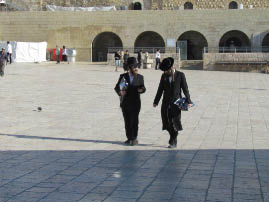
Old City of Jerusalem |
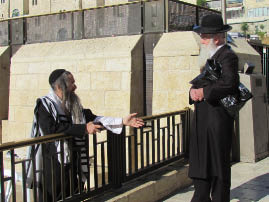
Old City of Jerusalem
|
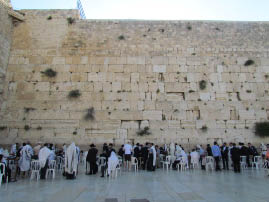
Western Wall |
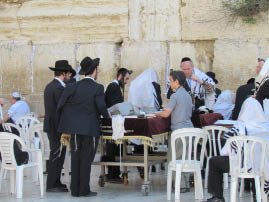
Old City of Jerusalem |
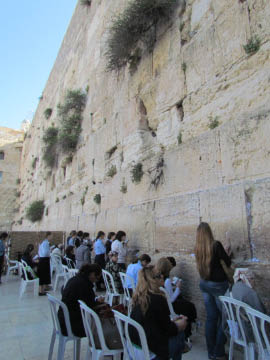
Western Wall |
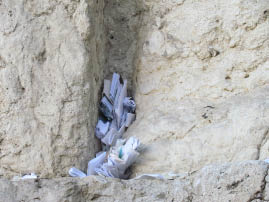
Notes to God |
Yael bought our tickets to tour the Western Wall Tunnels – a most amazing maze of chambers and cisterns adjacent to the underground protion of the Western Wall. In the entry hall, Yael showed us a model that illustrated how dramatically the landscape in the old city had changed over the years during the building and rebuilding of the city and the temples. Literally mountains of earth had been moved – and not by bulldozers – probably by slave-dozers.
Down inside the tunnels, we saw parts of the wall that have been perfectly preserved – in spite of Herod’s intense desire to destroy everything in sight. Some things are just too hard to leave in rubble. In that underground maze, we explored sections that had been hidden for almost 2,000 years. They had been sealed off until 1967 when excavations began. (There are still more ruins down there waiting to be discovered.)
Underground Temple Mount once housed a synagogue, a quarry, and a cistern. In the quarry, we got a vague idea of how workers (skilled masons) harvested the stone from the bedrock, making the building blocks for the ancient city. We saw how remnants of the underground walls, huge blocks of stone fit snuggly together like a puzzle. They did this with crude tools -- no lasers or no drills. Now that’s craftsmanship.

Western Wall Tunnels |
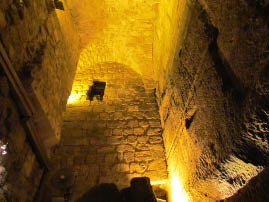
Western Wall Tunnels |
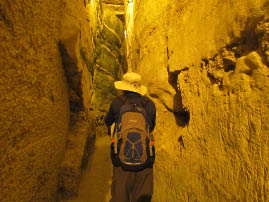
Western Wall Tunnels |
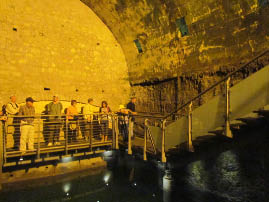
Western Wall Tunnels |
Down in these tunnels, we passed by chambers and hallways and sections where the women and girls come to pray and wail at the lower section of the Wall in privacy – not out in the open main courtyard.
We came up and out of the tunnels to emerge in a maze of temples and churches on narrow streets washed in the bright sunlight.
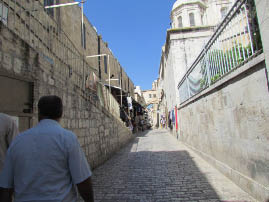
Old City of Jerusalem |
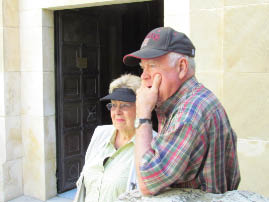
Pat and Don Pondering Old City of Jerusalem |
Next, we walked along the road “Via Dolorosa,” ("Way of Grief" in Latin). It’s a path where Jesus walked to his crucifixion with 14 stops (or stations) along the way. The first eight stations are along the old city road – most have had churches built over them. The last six stations are within the compound of the Church of the Holy Sepulcher (burial vault).
Christians from all over the world come here on a pilgrimage just to touch and see the 14 stations. I had never heard of the “Via Dolorosa” before today. My Catholic friends know about the route and do a mini 14 station walk back home as part of Easter or Lent services. Now we were walking in the footsteps of Jesus in the real place -- felt like a magical scavenger hunt.
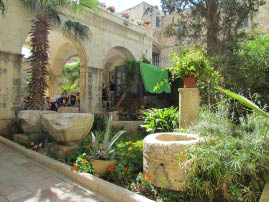
Via Dolorosa |
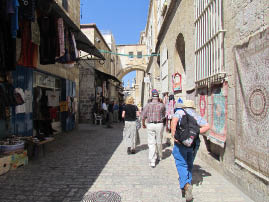
Via Dolorosa |
Along the route, we played leap frog with one very intense group of Christians from India, wearing orange baseball caps following their leader who was carrying a wooden cross. Their singing and praying along the way helped me experience what a spiritual pilgrimage must be like.
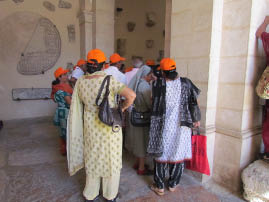
Via Dolorosa |
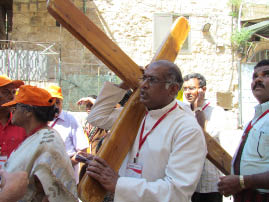
Via Dolorosa |
I tried to take in all 14 Stations on my own personal mission that day, but missed a few and probably got a few mixed up. It wasn’t that easy to follow – but here’s the list of the 14 stops.
- Jesus is condemned to death by Pontius Pilot
- Jesus receives His Cross
- Jesus falls the first time under His Cross
- Jesus meets Mother Mary
- Simon of Cyrene helps Jesus to carry His Cross
- Veronica wipes the face of Jesus
- Jesus falls the second time
- Jesus speaks to the women of Jerusalem
- Jesus falls the third time
- Jesus is stripped of His garments
- Jesus is nailed to the Cross
- Jesus dies on the Cross
- Jesus is taken down from the Cross
- Jesus is laid in the Tomb
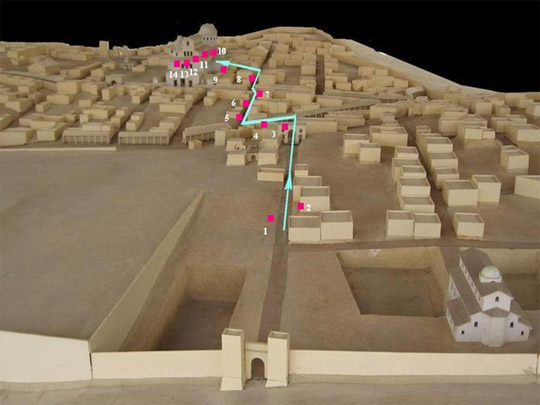
Via Dolorosa |
Station 1 is inside the Franciscan compound (Flagellation Church and Condemnation Church) where Pontius Pilot condemned Jesus to death and then said he’d wash his hands of the whole affair. “Then Pilate released Barabbas to them. But he had Jesus flogged, and handed him over to be crucified.” (Matthew 27,26)
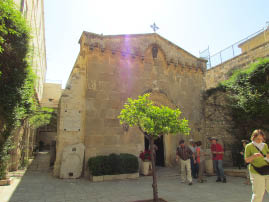
Flagellation Church |
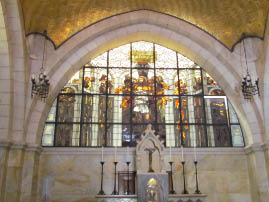
Condemnation Church |
Station 2 is a church over an old courthouse where the Romans gave Jesus his cross and crowned him with thorns as King of the Jews. “So the soldiers took charge of Jesus. Carrying His Own Cross, He went out to the place of the Skull (which in Aramaic is called Golgotha).” (John 19,17)
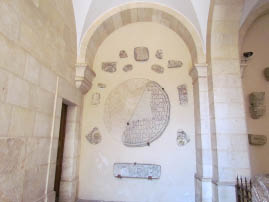
Station 2 |
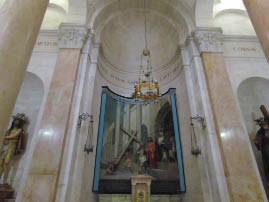
Station 2 |
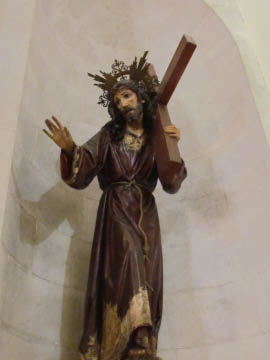
Station 2 |
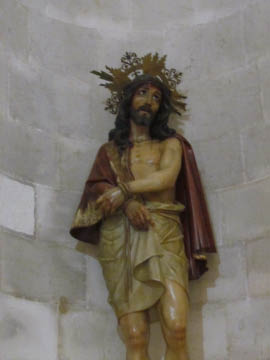
Station 2 |
We continued to Station 3, passing gardens and walking under the Ecce Homo Arch (Latin for "behold the man"). The triumphal arch is Early Roman (135 AD), built to honor the visit of Emperor Hadrian.

Walking to Station 3 |
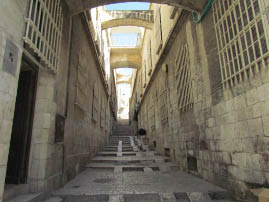
Walking to Station 3 |

Walking to Station 3 |
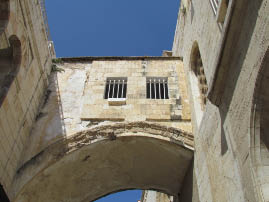
Ecce Homo Arch |
We made a stop at the Ecce Homo Basilica, built in 1868, with the entrance as part of the northern arch.
It’s here where Pilate presented Jesus to the crowds (John 19 5): "Then came Jesus forth, wearing the crown of thorns, and the purple robe. And Pilate saith unto them, Behold the man!"
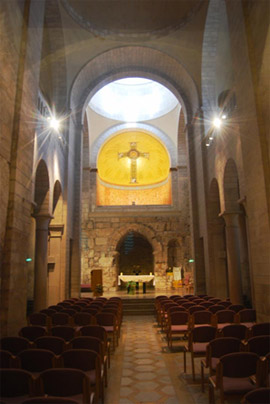
Ecce Homo Basilica |
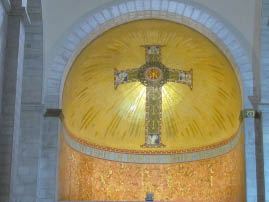
Ecce Homo Basilica |
Station 3 is where Jesus falls the first time under His Cross at the corner of via Dolorosa and El Wad (Hagai). A chapel was built by the Armenian Catholic church during the 15th century. It was renovated in 1947-48 with the financial help from the Polish army.
Being direction impaired, this was a disorienting place for me to grasp. It seemed as if we were going in and out; up and down all the while I was gazing at bright things that caught my attention. In fact, it was here in the basement where Dean fell going down the slippery steps. It was a bad fall – but luckily, he didn’t break anything and carried on like a trooper.
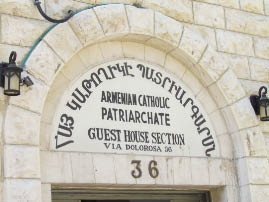
Station 3 |
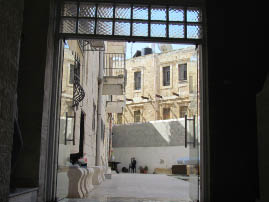
Station 3 |
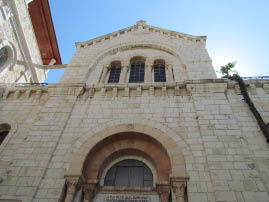
Station 3 |

Station 3 |
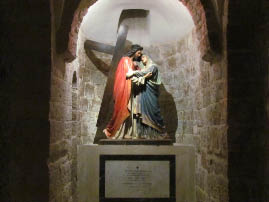
Station 3 |
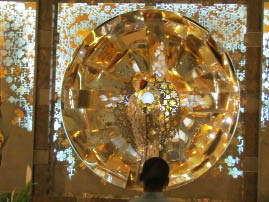
Station 3 |
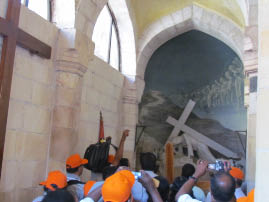
Station 3 |
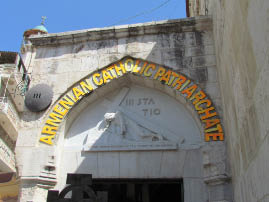
Station 3 |
Station 4 is where Jesus meets Mother Mary along the Roman cobble stone path with some of the same cobbles still in place today.
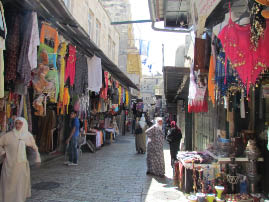
Roman cobble stone path |
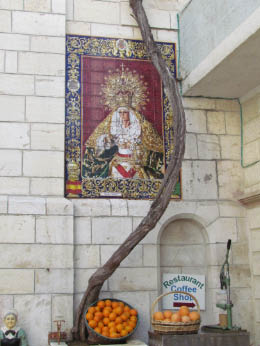
Station 4 |
Station 5 - A small Franciscan church, established in 1229, marks the spot where Simon of Cyrene (Cyrene is modern day Libya) helped Jesus carry His Cross. “As they led Jesus away, they seized Simon from Cyrene, who was on his way in from the country, and put the cross on him and made him carry it behind Jesus.” (Luke 23, 26)
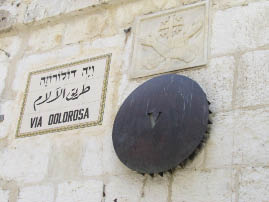
Station 5 |
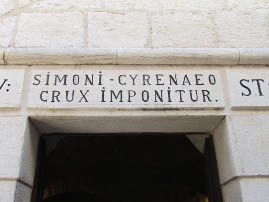
Station 5 |
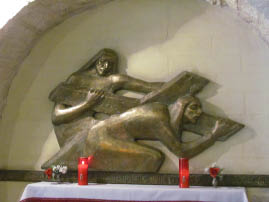
Station 5 |
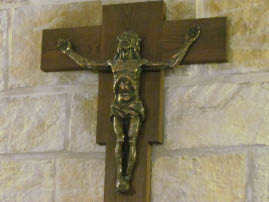
Station 5 |
Station 6, is dedicated to a woman, St. Veronica, who wiped Jesus face. The name, “Veronica.” may have been based on the Latin words "Vera"+"Icon", or "true image" because the face of Jesus is believed to be on a woman's handkerchief.
"The Holy Face," a small Greek Catholic chapel, commemorates where Veronica allegedly wiped Jesus face with a silk hanky. The chapel is in a small dark cave-like chamber, in stark contrast to the busy street outside. It’s interesting to note that Veronica doesn’t appear anywhere in the Bible of my Christian past.
Between two doors (one to the chapel, the other to a souvenir shop) is a pillar with crudely carved letters identifying Veronica’s station. I fofound the ancient carved signpost fascinating.
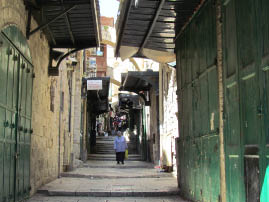
Station 6 |
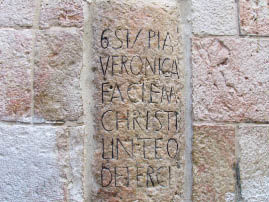
Station 6--Chaple of the Holy Face |
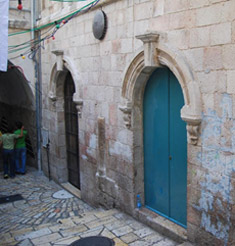
Station 6 |
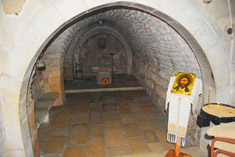
Station 6 |
Station 7 is where Jesus falls the second time under the weight of the cross just after he passed through the Gate of Judgment. This street is one of the busiest in the old city, as it may have been during Jesus times. Behind the door is a small chapel run by the Franciscans starting in 1875. (The top floor is closed to the public.)
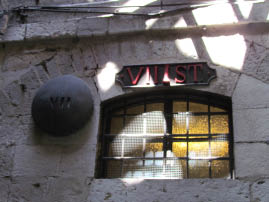
Station 7 |
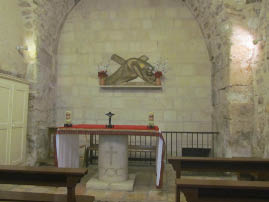
Station 7 |
Station 8 – is where Jesus comforts the sad women of Jerusalem. Women played a very big role in helping and supporting Jesus on this walk of suffering – I’m not surprised.
The station is dedicated by the Greek Orthodox to Saint Charalampos with their monastery right behind the wall. We must have whizzed right by this station because it wasn’t until my post-trip in-dept research that I discovered the ancient cross with the Greek inscription "NIKA" embedded on the wall right next to the postcard stands. ”NIKA” means something like victory and power. “A large number of people followed Him, including women who mourned and wailed for Him. Jesus turned and said to them, "Daughters of Jerusalem, do not weep for me; weep for yourselves and for your children...For if men do these things when the tree is green, what will happen when it is dry?" Luke 23, 27
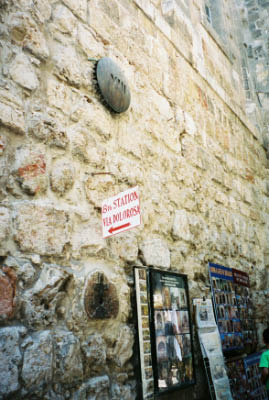
Station 8 |
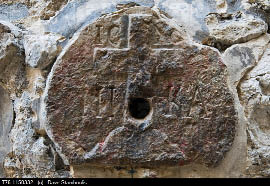
Station 8 NIKA |
Station 9 is where Jesus falls the third time. He is further up the hill and closer to the place of his crucifixion and his tomb in the Church of the Holy Sepulcher. On our way, we walked through a narrow alley around St. Helen Coptic Church. To me, it was the most picturesque place in all of Old Jerusalem, made even more picturesque by Monks or Friars or Rabbis or Sages or other religious folks on the pathways. They probably pass this way every day.
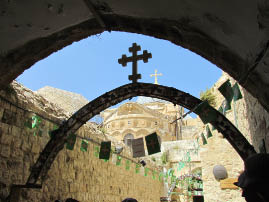
Narrow alley around St. Helen Coptic Church |
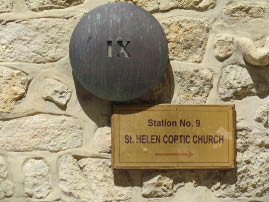
Station 9* |
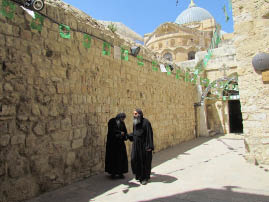
Station 9 |

St. Helen Coptic Church |
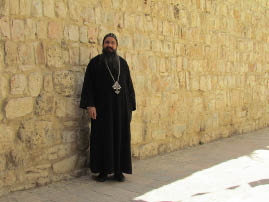
Station 9 |
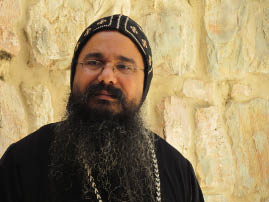
Station 9 |
Before we entered the Church of the Holy Sepulcher, Yael showed us the Ethiopian church of St. Michael chapel and the “bee-hive” quarters for the Ethiopian monks. The Ethiopian monks live in a kind of African village, called Deir es-Sultan, on the roof the Holy Sepulcher. The cells look very basic and probably very hot. Not an easy life if you’re an Ethiopian monk.

Quarters for the Ethiopian monks |
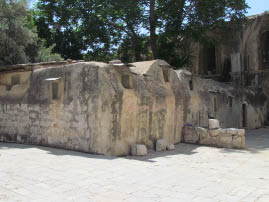
Quarters for the Ethiopian monks |
We entered the vast courtyard of the Church of the Holy Sepulcher – the most holy spot in this most holy town. It was crowded with tourists overwhelmed with what they were seeing, myself included.
Church of the Holy Sepulcher - Overview
The massive Church of the Holy Sepulcher sits over the “hill” of Calvary (Latin) or Golgotha (Aramaic) -- both words meaning “place of the skull.” Under the domes and rooflines are the sites of Jesus’ crucifixion, burial and resurrection. Calvary is directly under the small gray dome where Jesus was crucified. Under the large dome is Jesus’ tomb, once a limestone quarry.
The church has been destroyed and rebuild several times through the centuries. The church we see today was constructed by the Crusaders.
Building chapels and churches over holy spots has been common for hundreds of years. The churches are not there to serve a congregation that comes together to worship, but rather, they are a stopping point for pilgrims visiting sacred places. The Church of the Holy Sepulcher is a bewildering conglomeration of 30-plus chapels and worship spaces covering the sites of Jesus’ crucifixion, burial and resurrection. The results are dark, mammoth, aging chapels scattered about, vertically and horizontally, in a most disorientating floor plan. It’s difficult to imagine Christ dying on the cross and being carried to the tomb, all within the confines of a covered, dreary mish-mash of architectural styles.
To make matters worse, the Church of the Holy Sepulcher bears the scars of fires, earthquakes, vandalism and haphazard reconstruction down through the centuries. The Mother of all Churches in this holy of all lands, can be gloomy and filled with noisy visitors. No one can really take charge and spruce up the place without starting another Holy War. Yael told us about one exception. The powers that be managed to come together and install a modern bathroom before a visit from Pope John Paul – but otherwise, most things remain as they are -- in a sad state of decay.
The Church of the Holy Sepulcher’s main custodians and main owners are the Greek Orthodox, the Armenian Apostolic and the Roman Catholic (known in the Holy Land as Latins). Coptic, Ethiopian and Syriac Orthodox religions have a smaller piece of the pie. The church is parceled into sections (with a great deal of dispute over who owns what) with a set of complicated rules to govern the common area – especially where the visitors walk from one area to another. Yael said that fist fights between the monks and priests are not uncommon.
In the courtyard Yael pointed to a ladder that was placed on a ledge around 1850. It was used to get food to Armenian monks locked in the church by the Turks. Without general agreement, the ladder may not be moved. No one dares touch it and take the chance of provoking the wrath of the other religious sects – Crazy!
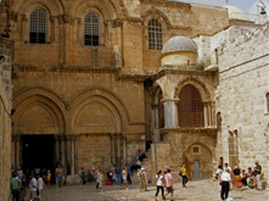
Courtyard of Church of the Holy Sepulcher |

Church of the Holy Sepulcher |
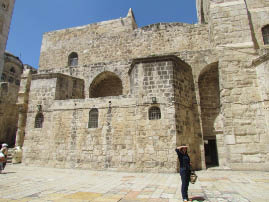
Church of the Holy Sepulcher |
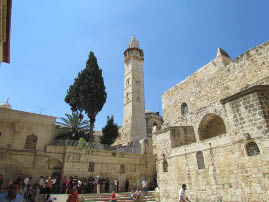
Church of the Holy Sepulcher |

Lunch at Church of the Holy Sepulcher |
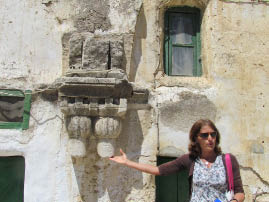
Yael at Church of the Holy Sepulcher |
Also due to the constant in-fighting of the Christian caretakers, two Muslim families (the Nuseibehs and the Joudehs) hold the key to the church’s entrance doors and have since the 12th century. The decision for these Muslim families to lock and unlock the three ton doors everyday was made to keep down the tensions between the Christian groups who wanted to control of the site. (Ahmed, our guide in Jordan, told us this story to prove Muslims are highly trustworthy.)
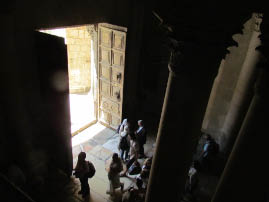
Church of the Holy Sepulcher |
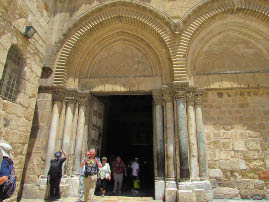
Church of the Holy Sepulcher |
Yael led us through the sprawling Church of the Holy Sepulcher, finding a tucked away corner here and there, away from the crowds, so she could explain what we were seeing. We picked up our mission of the 14 Stations of the Cross, with only five to go – the last five are within the confines of the Church of the Holy Sepulcher. The place was mind boggling – kind of like a Fellini movie.
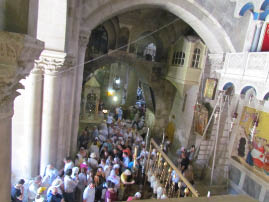
Church of the Holy Sepulcher |
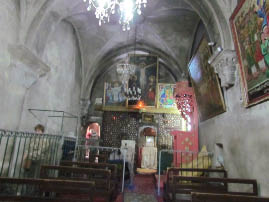
Church of the Holy Sepulcher--Station 10 |
Station 10 - Jesus is stripped of His garments
Yael led us up the outside stairs and into the small worship space called the Chapel of the Franks where Jesus was stripped of his garments. They took His clothes, dividing them into four shares. One for each of them, with the undergarment remaining. (John 19, 23)
NOTE: We didn’t do the last five stations in sequential order so I’m taking some poetic license and reporting about them in numerical order just to satisfy my need for orderliness.
At the main entrance, we took a stairway to Calvary – 18 steps up and we were on floor level with the top of the hill, or rocky outcrop, where Jesus was crucified. On this floor, built over Calvary are two chapels side by side, Greek Orthodox on the left, Catholic (Franciscan) on the right. Yael told us that the Priests and Cardinals who guard these adjacent chapels get into frequent brawls over how to run the chapels. She said the Catholic priests are pretty good fist fighters.
Station 11 - Jesus is nailed to the Cross
Station 11 is the Catholic Chapel of the Nailing to the Cross. It was dark in that corner chapel so I didn’t get a good look at the artifacts. The altar was made in Florence, Italy in 1588 and donated by Cardinal Medici. All I remember is the group sitting in the wooden benches along the wall, trying to hear Yael and absorb what we were seeing. It was really too dark for me to get any good pictures.
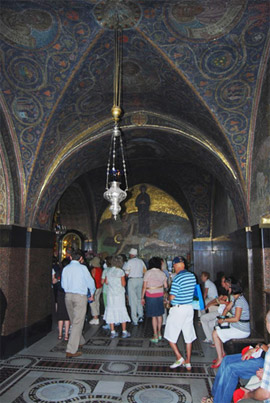
Station 11-
Catholic |
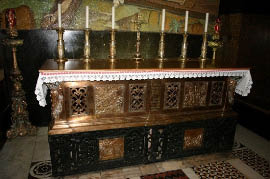
Station 11 Alter |
"And then they were come to the place, which is called Calvary, there they crucified him..." Luke 23:33. Then they offered him wine mixed with myrrh, but he did not take it. And they crucified him. Mark 15, 23
Station 12 - Jesus dies on the Cross
The Greek Orthodox Chapel of the Crucifixion is much brighter and more ornate than its Catholic neighbor. This is the station where Jesus dies on the cross. Jesus is on the cross with silver icons of Virgin Mary and St. John on each side.
You could see the original limestone rocks of Calvary under Plexiglas on both sides of the altar. The limestone is from a quarry that was just outside the city walls during the time of the crucifixion. The glass is there because, through the centuries, visiting pilgrims have chipped off souvenirs from these holy sites.
I watched the line of visitors crawl up underneath the altar to a silver disc on the floor. A hole was cut in the center marking the spot where the Cross stood. One by one, each person kneeled and kissed the spot and touched the limestone rock of Calvary before moving on to the next station.
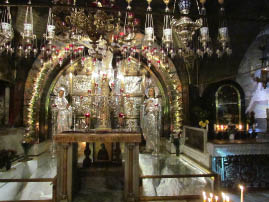
Station 11--Greek Orthodox |

Station 11--Greek Orthodox |
Seeing the dark, aging chapels perched over Calvary, I had to remind myself Christ was actually crucified outside on a hill. Carrying his own cross, he went out to the place of the Skull (which in Aramaic is called Golgotha). Here they crucified him. ...for the place where Jesus was crucified was near the city. - John 19:17, 18, 20. It was now about the sixth hour, and darkness came over the whole land until the ninth hour, for the sun stopped shining. And the curtain of the temple was torn in two. Jesus called out with a loud voice, "Father, into Your Hands I commit my spirit." When he had said this, He breathed His last. (Luke 23, 44-46).
The Catholic altar of Our Lady of Sorrows, located between the two chapels, commemorates where Jesus is taken down from the cross. We had finished with the Calvary floor and went down a flight of stairs to return to the ground floor.
Station 13 - Jesus is taken down from the Cross
Immediately inside the main door of the church, located midway between Calvary and the tomb is a large marble slab -- the Stone of Anointing. According to tradition, the body of Jesus was removed from the cross and laid on this stone. Here Joseph wrapped Jesus’ body and Mary and the women applied the spices to prepare it for burial. The stone today is not the original stone. This one was put here in 1808 to replace the one destroyed by fire from the crusader period. I watched streams of people kneel and pray by the stone, touching, caressing and even kissing it. Some were rubbing the slab with olive oil.
On the wall behind the stone hangs a large Greek mosaic depicting Christ being taken down from the cross, His body being prepared for burial and taken to the tomb. It’s a very moving piece.
Eight lamps hang directly above the Stone of Anointing, each donated by one of the denominations – nice touch.
Later, Joseph of Arimathea asked Pilate for the body of Jesus. Pilate agreed. "Then took they the body of Jesus, and wound it in linen clothes with the spices, as the manner of the Jews is to bury". (John 19, 38, 40).
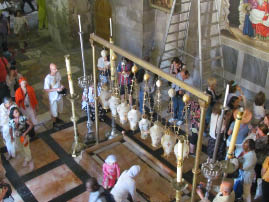
Station 13 |
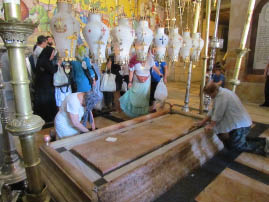
Station 13 |
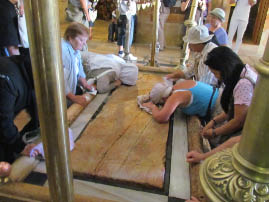
Station 13 |
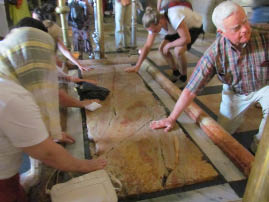
Station 13 |
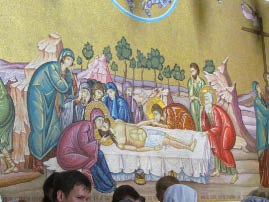
Station 13 |
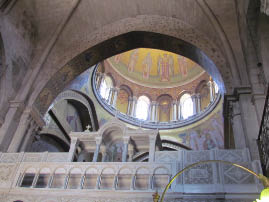
Station 13 |
On the way to the tomb, Yael pointed out the Armenian stop for worship. So odd how they scatter this chapels around.
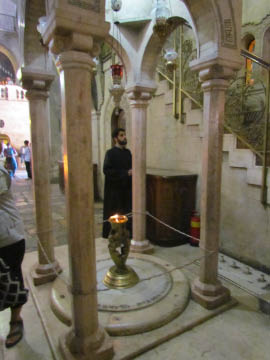
Armenian stop for worship |
Station 14 - Jesus is laid in the Tomb
We walked to the round enormous Rotunda, our final station of Via Dolorosa. The Rotunda is held up by massive pillars and topped by a huge dome. Its outer walls date back to the Emperor Constantine’s original basilica built in the 4th century.
Right in the middle of the Rotunda is the Holy Sepulcher, the Tomb of Jesus. A Byzantine church was built over the tomb, then a couple of larger churches were built over those churches. It’s prime real estate – the place where Jesus was buried for three days and then arose from the dead. In 1808, during some ritual that required fire, the current church caught on fire. Because nobody can renovate the place, the scars from the fire remain on the chapel. Inside are two chambers. In the outer one, known as the Chapel of the Angel, stands a pedestal containing what is believed to be a piece of the rolling stone used to close the tomb.
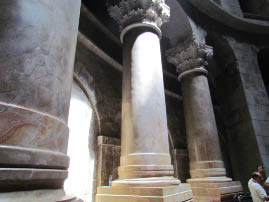
Station 14 |

Station 14 |
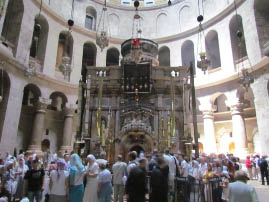
Station 14 |
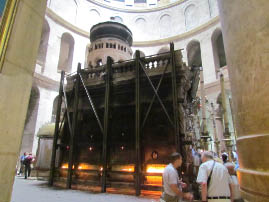
Station 14 |
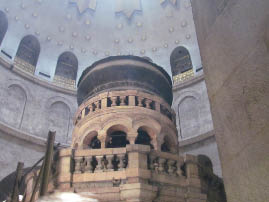
Station 14 |
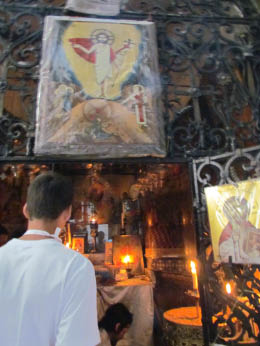
Station 14 |
The place can get very, very busy. We didn’t stand in line to see the actual tomb of Christ. Instead, Yael showed us a substitute first century tomb right behind the small Syrian Chapel, just a few steps from the tomb of Jesus. Here we could explore a tomb from the time of Christ cut into the same abandoned quarry. We peeked into the cave with the dug out graves -- kind of spooky. We saw where bodies were laid after they were wrapped in cloth and spices. After about a year, the decayed bodies and bones would be moved to an ossuary box.
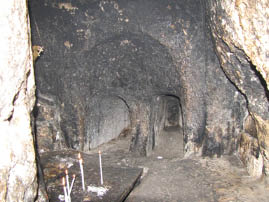
Burial Cave |
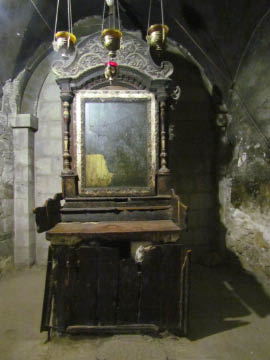
Burial Cave |
Taking Jesus' body, the two of them wrapped it, with the spices, in strips of linen. This was in accordance with Jewish burial customs. At the Place where Jesus was crucified, there was a garden, and in the garden a new tomb, in which no one had ever been laid. Because it was the Jewish day of Preparation and since the tomb was nearby, they laid Jesus there. (John 19, 40-42)
There, we were done with the 14 Stations of Jesus – but still had some more sightseeing left in the Church of the Holy Sepulchre
Yael led us to a central worship space right off the Rotunda, known as the Katholikon (or Greek choir.) It’s owned and operated by the Greeks and the best spot in all of the Holy Sepulcher. It was magnificent.

Church of the Holy Sepulcher--Rotunda |

Church of the Holy Sepulcher--Rotunda |
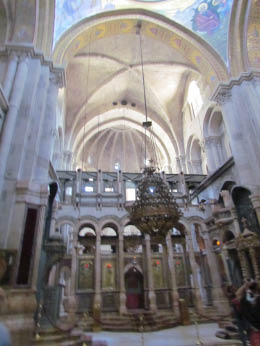
Church of the Holy Sepulcher--Rotunda |
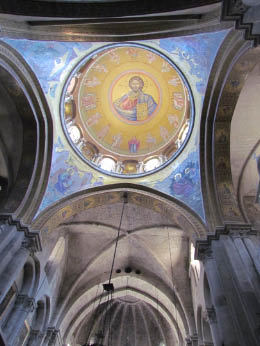
Church of the Holy Sepulcher--Rotunda |
We stopped to see an omphalos (Greek for navel), an ancient religious stone, and very sacred. According to the ancient Greeks, Zeus sent out two eagles to fly across the world to meet at its center, the "navel" of the world during the time when the world was flat. A few omphalos stones were used to denote “centers” surrounding the Mediterranean Sea; the most famous of those was at the oracle in Delphi. And here we were right in front of another one. Based upon the medieval cosmology, Jerusalem was the spiritual, if not geographical center of the world. Wish I had paid more attention to that stone – didn’t look that impressive.

Church of the Holy Sepulchre |

Omphalos Stone |
There were wonders a plenty in that dark, somewhat gloomy, Church of the Holy Sepulcher. My brain was on overload and I was happy to head for those big doors and out into the glorious sunlight of Old Jerusalem. After strolling the winding streets we had lunch at Rossini's Restaurant– a fancy Italian cave-like restaurant in the old city. I liked the place. We sat across from Don and Pat and tried to recall what we had learned that morning. Bill and I had a large beer, which didn’t help our memory recall.
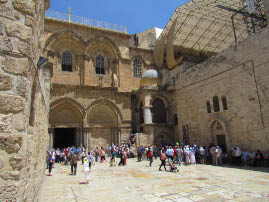
Church of the Holy Sepulchre |
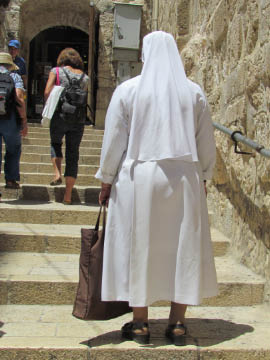
Old Jerusalem |
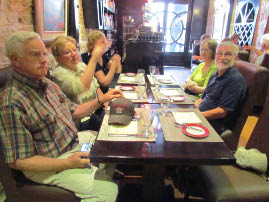
Rossini's Restaurant |
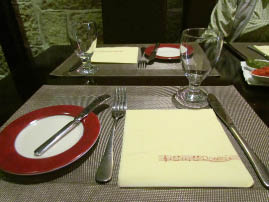
Rossini's Restaurant |
After lunch, we had a 20-minute shopping run. Bill and I were enticed into a fabulous shop by Amen, a guy with a terrific American accent. He makes the jewelry. I promptly spotted some earrings he made of glass from the ancient Romans -- trust me, I believe they are real glass from the ancient city of Jerusalem. Things don’t speak to me that often, these did and so we splurged. Bill has been very agreeable lately.
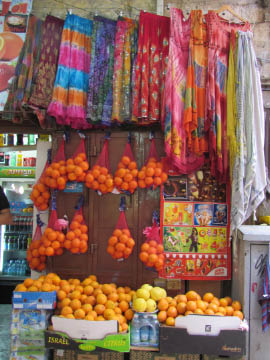
Old Jerusalem |
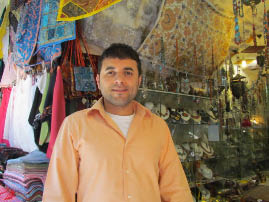
Amen the Jeweler |
Yael gathered us up to visit the Roman main street (Cardo) with a marketplace tucked behind. Cardo is reconstructed from a Sixth Century Byzantine city main street, going from north to south (from the Damascus Gate to Mount Zion). A section has been restored with pillars standing as they did in the past. During the Crusader period, a section of the Cardo became the market with “niches” for the shops. Today, some really pricey galleries blend in nicely with the ancient marketplace.
We stopped at a map of the old city – in fact it was the first map ever made – we’d see it in Masaka, Jordan with Ahmed – but now we could really understand what we were seeing.
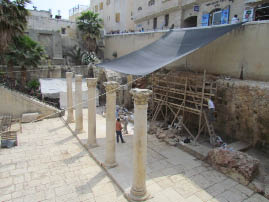
Cardo |
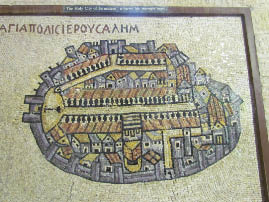
Ancient Map of the Old City |
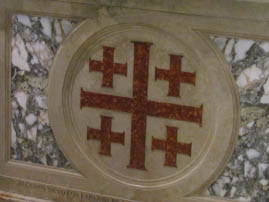
Old City of Jerusalem |
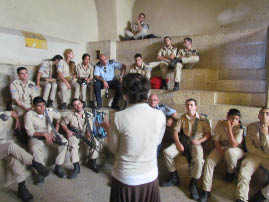
The ubiquitous military |
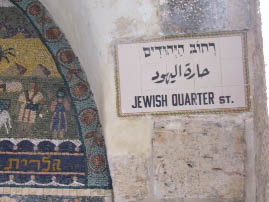
Jewish Quarter |
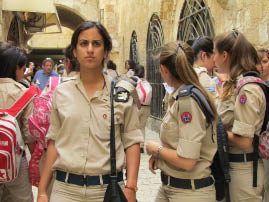
The ubiquitous military |
A lot of school kids, with their loud voices began to fill the place. (No wonder I had a short-lived teaching career.) We went through Zion’s Gate and thought about our little darling little granddaughter, Zion.
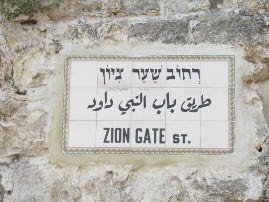
Zion Gate |
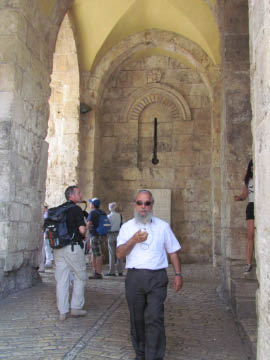
Old City |
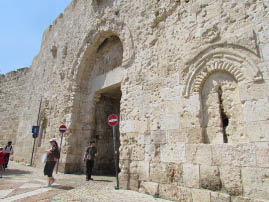
Zion Gate |
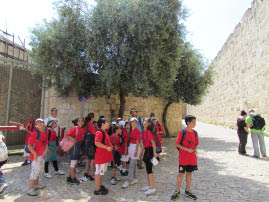
Lots of school kids |
After a few more mazes and twists and turns, Yael led us to a 12th century Crusader structure on Mount Zion. On the ground-level are several Jewish synagogues. The second level is a holy place for Christians - the location of the last supper, a dining hall built on top of King David's tomb. The third level has a Muslim muezzin tower. The Tomb of King David is holy to Jews, Christians and Muslims.
We first visited the traditional Christian site of the Last Supper (Coenaculum) at Lazarus’ house. Jesus came to the Old City to be with his friends to celebrate Passover. He had to sneak in because the Romans clearly wanted to get him. Yael said during Passover in pre Jesus times, the Jewish people told the story of Moses freeing the people from Egypt. Then after Jesus, there were two stories to tell, Moses and then the resurrection of Jesus. The Christians now tell the story of Jesus (and changed Passover into Easter) while the Jews stick with the Moses story.
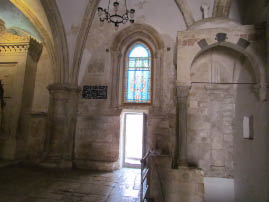
Site of the Last Supper |
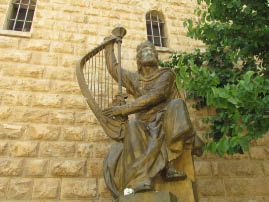
Ancient Map of the Old City |
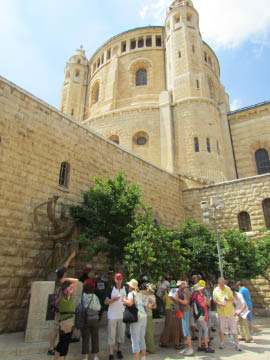
Old City of Jerusalem |
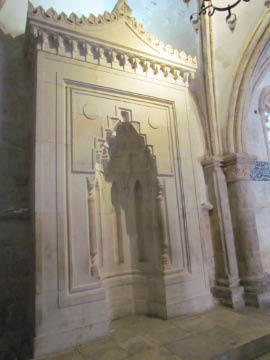
Tomb of King David |
It seemed as if our whole group had run out of gas when Yael lead us down some stairs to visit the tomb of David. It’s doubtful that he’s actually buried there – but there were a lot of shy, but sexy, Asian girls posing in front of it.
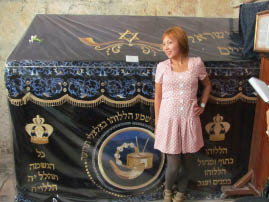
Shy, sexy Asian girl |
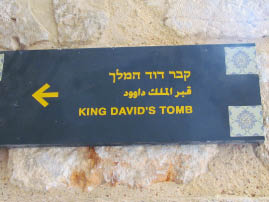
Tomb of King David |
We waited patiently on a parking lot for the bus. A few, not so shy, cats greeted us. The driver was stuck in traffic because of a big fire in the valley.

Not-so-shy cat |
We finally got back to hotel to regroup and check emails. For dinner, we were on our own, so Bill and I walked back to the Old City and searched for Moses Art Café -- but it was closed so we found another Fodor’s recommendation. We shared a Muslim version of chicken burrito that was very tasty. The place was very nice -- just our kind of joint. We were the only guests. The world-wide recession is not good.

Walls of the Old City |

Walls of the Old City |
We walked back through the Old City. It was great seeing the neighborhood as it really is -- kids running in the streets, mothers pushing baby carriages, holy men studying their books, shop keepers closing up and even some holy guys out for a jog.

Old City of Jerusalem |
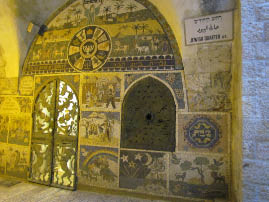
Old City of Jerusalem |
I was struck by how many markets there were -- alley after alley – full of vendors. We wandered into the butcher shop area just while they were closing up. Pretty disgusting to see the remains of the day -- left over carcasses with blood dripping down the narrow streets. We quickly got back to the stalls of scarves and t-shirts so we wouldn’t slip in the blood. It was great to explore the ancient city on our own. What a beautiful day -- maybe a little too much religion for Bill, but I enjoyed it. My brain synapses are firing images from my old Bible belt days.
5/9/12 - Wednesday - Day 2 in Jerusalem
After another very large and satisfying breakfast, we headed to Yad Vashem, a museum and memorial complex built on the Mount of Remembrance. Its purpose is to remember the six million Jewish people murdered in the Nazi Holocaust.
The Israeli Parliament established the memorial in 1953, but they rebuilt it in 2005. Moshe Sadfie was the architect. The entrance building had nice clean lines, nothing special – nothing popped out at us. Bill and I didn’t fully appreciate the design of the building or the grounds until we were in the book store afterwards and saw wide shots of the place – then we got it. Sadfie’s mind thinks out of the box and he created something beyond human thinking. The buildings are placed in a triangle to represent half the Star of David because half the Jewish population died during the Holocaust. The most mind-blowing for me is that he cut the whole museum through the mountain. You enter from one side of the mountain and come out on the other side towards the north. The museum bursts out of the mountain into, again, a view of light and of the city and of the Jerusalem hills.
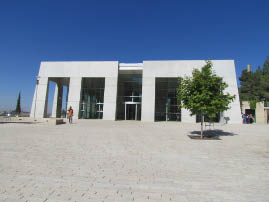
Yad Vashem Holocaust Museum |

Yad Vashem Holocaust Museum |
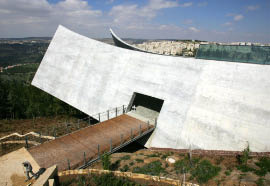
Yad Vashem Holocaust Museum |
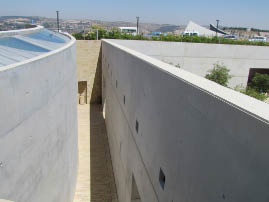
Yad Vashem Holocaust Museum |

Yad Vashem Holocaust Museum |
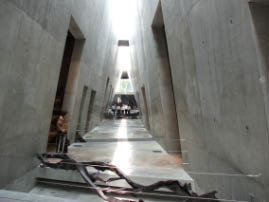
Yad Vashem Holocaust Museum |
Ten chambers, or galleries, are carved in the rock below grade level. You pass through the rooms, each designed to elicit a different time period leading up to the war and Holocaust.
The early rooms showed what life was before the atrocities of man’s inhumanity to man. The family photos, taken in Pre-Hitler days, with smiling faces were the toughest for me to take – wedding pictures, pictures of families on a picnic, and pictures of children. One room, The Warsaw Ghetto room, was built to look like the streets of Warsaw’s Ghetto while images of what happened there played in nearby rooms. Lots of film footage of Hitler in his heyday and proud cheering Germans were used in the displays. Also, videos of the survivors telling of their personal horrors like watching their mother die. There were many items that caught my eye and haunted me. Here are just a few that I remember:
- Crude measuring devices the SS used to determine the size of the Jewish nose, head, etc. along with documented photos of their use
- Trunk load of diaries written in secret (in Warsaw) and buried under the streets so that these stories would have a chance to be told
- The dolls left behind
- The diamond and emerald necklace – smuggled by a Jewish couple to use for cash. They never had to sell the necklace. After a long life the wife passed away. The husband donated the necklace in memory of his wife.
- The poetry -- the art work
- The brave resistant fighters
I was weak-kneed from the Hall of Names, a large circular room housing the extensive collection of “Pages of Testimony.” A large hole dug into the ground that represents the thousands of Holocaust victims that remain nameless or who have not been accounted for. The hole is literally dug into the ground and the museum has been built around it. You stand on a catwalk hung over the large hole and stare down into the hole.
“Pages of Testimony” are short biographies of each Holocaust victim. Over two million Pages are stored on shelves lining the circular room, with room for six million in all. The ceiling of the Hall is a dome with 600 photographs of the victims reflected in water below. This exhibit represents a fraction of the murdered six million men, women and children from the diverse Jewish world destroyed by the Nazis and their accomplices.
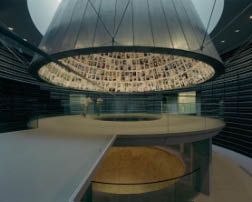
Hall of Names |
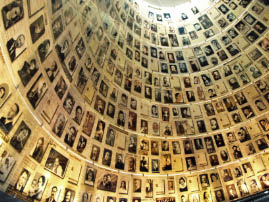
Hall of Names |
The museum’s name, Yad Vashem, means “a name and a place” (from Isaiah 56:5 - Even unto them will I give in mine house and within my walls a place and a name better than of sons and of daughters: I will give them an everlasting name, that shall not be cut off.) The museum’s goal is clear -- to give a name and place to the six million Jewish people exterminated in the Holocaust. Very powerful room.
We had spent about an hour or so walking though the displays. Most of us were in silence and overcome by the experience. It was a relief when the museum, cut through the mountain, ended and we were free to walk outside into the light and onto a large deck with an expansive view across Jerusalem. I felt like the building imprisoned us and then released us to a new horizon and brighter days – Maybe that’s how good design speaks to the soul.
With not much time left, we skipped quickly down the Avenue of the Righteous through the memorials around the grounds. I was sorry to miss the endless flame built to remember the children victims of the Holocaust. There were other memorials that I recall as we dashed by – places honoring individual gentiles who risk their lives to help the Jewish people, places to remember the concentration camps, places to give tribute to the free fighters and so on. It was a beautiful day, but I was zapped by the experience … with more to come.
At 11:30, Yael gathered us into a basic conference room in the main entrance and introduced us to Marta Wise, a Holocaust survivor, volunteering as a guide at Yad Vashem. In her quiet way, Marta told us a harrowing story of suffering and miraculous survival against all odds. We sat riveted to her every word for well over an hour.
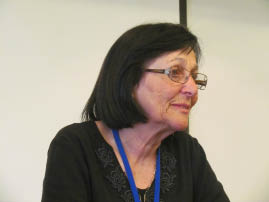
Marta Wise |
Marta Wise was born on 8 October, 1934, in Bratislava, Czechoslovakia. Her parents were Eugen Yaakov and Margaret Meital Weiss. She had 8 sisters and a brother.
She came from a privileged family. Her father owned and managed a textile factory. His factory was taken over by the SS after the invasion. The father was kept on as “The Essential Jew” to keep the factory running. The SS officer in charge couldn’t even sign his name.
When things got hot, the nanny couldn’t take the children to play in the park. Because of their resources, the parents were able to farm out the children for protection. The father made a deal with the nanny. He’d give her the factory and the house, if she would take on Marta and Sister Eva. Things were going fine until the nanny takes up with a new boyfriend who happened to be an SS soldier. She could no longer protect the girls. However she was able to offer something much better – passports (non Jewish passports) from her cousin’s children.
Marta was only 10 at the time when she and her sister were sent (as Christians) to Bratislava. Somehow they lived in an apartment on their own. The older sister played chess and made friends with SS. The cover didn’t last. Marta felt it coming. Every day she pretended to be playing in a yard, when in fact, she was actually digging a hole to escape. The troops got wise and in October of 1944, they come to the apartment to arrest the two girls. They took them to a prison and interrogated them for a week. The older sister was beaten. Finally the girls confessed to being Jewish -- and just a few minutes later, a neighbor arrives to testify on their behalf that the girls were gentiles -- but it was too late.
On 3 November, 1944 Marta and Eva were sent on a 3-day train ride with no food to Auschwitz-Birkenau. When they arrived, there was much confusion about which door to go into. Somehow they escaped the door leading to the gas chamber and were put in a dormitory. They worked and almost froze to death.
Luckily they were picked to be in the infamous “Angel of Death” Dr. Josef Mengele’s experiments. For genetic reasons, he picked twins and dwarfs for his ghoulish research. Marta never found out why she and Eva were sent to the experimental barracks because they were not twins and did not even look alike. They were bled daily and given numerous injections, never learning what they were being injected with. She described Mengele as a monster, a psychopath and a schizophrenic -- someone who introduced himself as "Uncle Mengele," held and cuddled a child on his knee, give them candy and then ordered the child’s murder a moment later.
Marta and Eva were probably saved by being the subjects of Mengele's research because they were kept in Mengele’s medical experiments block with the twins and dwarfs. They were better fed and housed than the ordinary prisoners. And, for the time being, safe from the gas chambers, although many experiments resulted in more painful deaths.
NOTE: Mengele never got justice. After the war, he lived incognito in Germany before he fled to South America, where he evaded capture for the rest of his life despite being hunted as a Nazi war criminal.
In addition to the daily torments of medical experimentation, starvation, disease and exposure, Marta was also tortured by the inhumane guards. She was thrown into a sewer so they could make bets on how long she could survive. She was rescued by a fellow prisoner, risking his own life.
Marta recalled another time when inmates were forced to watch the agonizing death of a fellow prisoner who had tried (and failed) to tell a Red Cross delegation the atrocities that were taking place here. The Red Cross didn’t believe the woman. The SS convinced them that she was just crazy. After the Red Cross left, the woman was injected with petroleum.
Times got tougher and tougher in the camp. There was less and less food. Eva comes down with dysentery and was sent to the hospital. Marta stayed by her side. The SS troops were gathering up the surviving Jews for a death march because the Russian troops were closing in. The SS troops let the two sisters join in the march because they were so frail and incapable of walking even a short distance. With the Russians closing in, the SS troops changed their death march plans. They don’t want to leave any evidence behind so they gathered up all the remaining prisoners, circled the wooden wagons around them and then set the wagons on fire. Marta and Eva thought that would be the end, but heavy rains come and put out the fire out.
Their four-month long battle in Auschwitz ended. They managed to stay alive until the liberation by the Red Army on 27 January, 1945. They were rescued by the Soviet troops. The troops had no food and didn’t know what to do with the girls, so they gave them all they had – a shot of vodka -- to begin their road to recovery.
The sisters found their way back to their home. Their house has been taken over, but one floor remained. The father survived -- the only one from his side of the family of 180. The mother was alive and the two youngest daughters (who were adopted out) were returned -- only because one had a distinctive birthmark. The old brother also returned home, but died shortly after.
After the war, Marta moved to Australia, where she became a historian. She immigrated to Israel in 1998, and lives in Jerusalem today. She is a mother of 3 and grandmother of 14.
Marta and Eva never spoke a word of their horror until 1995. One of them was speaking to a group in Australia and wanted the other one to come. Since then that’s all they talk about. They want to share their story so it will never happen again.
Marta touched us all with her willingness to share her painful past. Marta said there were two ways one could try to survive in the camp. One is to become completely dehumanized and fight only for yourself. The other is to simply hang on, finding courage and hope and helping one another as much as possible. Then, at least, you’ll have the moral victory of preserving your basic humanity.
Marta’s story is documented in Steven Spielberg’s film, Survivors of the Holocaust.
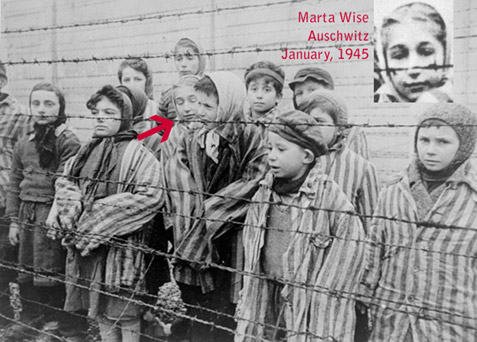
A still photograph from a Soviet film of the liberation of Auschwitz shows Marta with other survivors of Auschwitz, wearing an adult-size prisoner jacket, standing behind a barbed wire fence. |
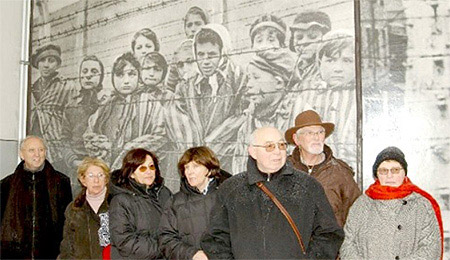
On 27 January, 2005, 60 years after they were photographed by their liberators, the six survivors living in Israel took part in a ceremony in Poland marking 60 years since the liberation of Auschwitz. Marta is second from left. |
After Marta’s talk, we went to the bookstore – very nice. We tried to have lunch in the cafeteria, but the place was packed. For some reason, a group of soldiers were passing out free sandwiches – big ones at that. We gladly accepted them. Who says there’s no such thing as a free lunch? We ate the sandwiches on the bus. Pat and Don weren’t in the crowd when we got the new departure time so we didn’t leave until around 2.
We drove to the Mount of Olives, a hill facing the old city of Jerusalem, named for the olive trees that have grown on its hillside from ancient time. We stopped for a panoramic view of the Dome onf the Rock and the Old City.

Dome on the Rock and the Old City |
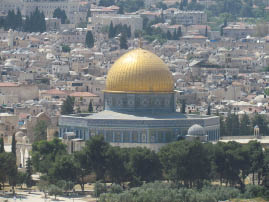
Dome on the Rock |
There were thousands of tombstones in an old Jewish cemetery (thought to be the oldest in the world). This has been prime burial real estate for over 2,000 years. Jews want to be right here to await the coming of the Messiah and the resurrection that follows. They believe the Messiah will enter the city of Jerusalem along this path and scoop up the dead from the graves (starting right here). Christians already believe he came through on the first Palm Sunday. Whatever – it is a grand location for a semi-final resting place.

Old Jewish Cemetery |
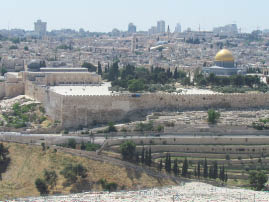
The Old City |

Old Jewish Cemetery |
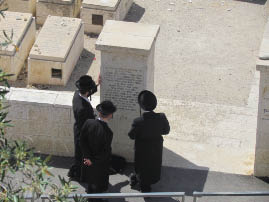
Old Jewish Cemetery |
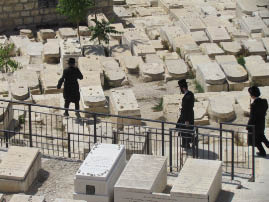
Old Jewish Cemetery |

Bill and Nancy in front of Dome on the Rock |
The area on the Mount of Olives is also called Gethsemane (Hebrew for “oil press”). It’s the garden where Jesus came to pray the night before he was arrested and crucified.
The Basilica of the Agony (also called the Church of All Nations) stands near the foot of the Mount of Olives. It’s a Catholic Franciscan church, built in 1924 and happens to be the third church built over the rock where Jesus prayed in agony the night before he was crucified. The interior domes of the church are painted to look like a star-studded night sky, with the stars surrounded by olive branches. The Italian Friar, Antonio Barluzzi, was the architect. He also designed The Church of the Beatitudes – I liked this church better.

Basilica of the Agony |
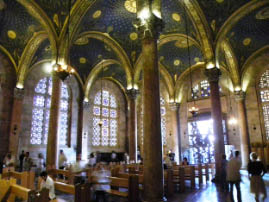
Basilica of the Agony |
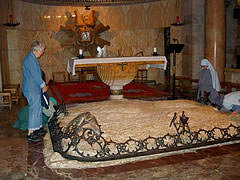
Rock of Agnony |
Just up the hill, north of the church, is the Grotto of Gethsemane, where Jesus and his disciples often camped at night. Near the grotto is the Tomb of Mary, where it is believed that Mother of Jesus was buried after she “fell asleep” in death
What the Bible Tells Us:
The Gospels of Matthew, Mark and Luke tell that Jesus and his disciples went to the Mount of Olives after the Last Supper (at Lazarus’ house). Jesus left eight of the disciples together in one place and continued on with Peter, James and John. He asked them to stay awake with him while he prayed.
Jesus “threw himself on the ground” (Matthew 26:39) and in his anguish “his sweat became like great drops of blood falling down on the ground” (Luke 22:44). But the three disciples, all of them fishermen who were used to working through the night, could not stay awake “because of grief” (Luke 22:45).
Then, by morning, a group from the chief priests and elders arrived to arrest Jesus. They were led by Judas, who betrayed his Master with a kiss. |
I was disappointed in my Garden of Gethsemane experience. I was hoping I could stroll through the peaceful garden, see the ancient olive trees up close and perhaps, walk in Jesus’s footsteps. We just got a peak at the garden from our bus window as we drove by hundreds of tour buses parked along the road. Reality is sometimes different from expectations – but that was fine because it was a long packed day and closing in on beer time.
Yael disbursed the group at bus stops along the way -- where we wanted to be delivered. Don, Pat and Dean set out with us for our tour through the Center City. We walked through markets and stopped for a beer at a place run by a Punkish Jewish Refugee from New Jersey. Beautiful day -- great beer.
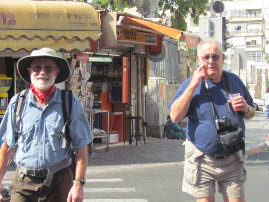
Bill and Dean in Centre City |

The market in Centre City |

The market in Centre City |

The market in Centre City |

The market in Centre City |
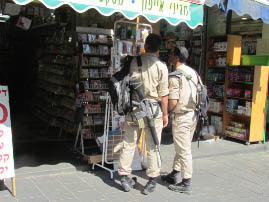
Shops un Jerusalem |
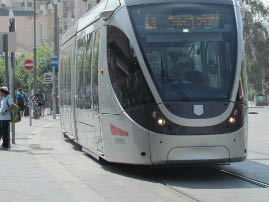
Trolley |
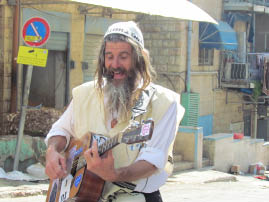
Music in Jerusalem |
We walked back to our hotel. Bill and I regrouped and then walked up to the Supermarket down the street and got some bread and cheese for dinner. I also got what I thought was a half pint of milk. We came back to the hotel and found a lovely spot on the hotel grounds to have our bread and water (and cheese). The Mt. Zion Hotel is awesome – Check out these photos of the place.

Mt. Zion Hotel |

Mt. Zion Hotel |

View from Mt. Zion Hotel |

Mt. Zion Hotel |

Mt. Zion Hotel |

Mt. Zion Hotel |

Mt. Zion Hotel |

Mt. Zion Hotel |

Mt. Zion Hotel |

Mt. Zion Hotel |
Back at the room I caught up on my journal. Just about bedtime, I wanted to treat myself to a little milk and the Cheerios I’d brought from home -- my comfort food. The milk turned out to be thick and gooey, certainly not milk -- too bad I can’t read the labels in Hebrew. Another bit of bad news -- the Stock Market is tanking which has a ripple effect on us on the road.
5/10/12 - Thursday - Jerusalem - Day 3 / Bethlehem
After an early breakfast, we went to a conference room at the hotel where a Palestinian guide gave us his side of the Palestine / Israel conflict. He had studied in Chapel Hill, N.C. His English and presentation skills were excellent and he was very passionate about his message. I’m sorry I didn’t get his name or photo. For purposes of this journal, I’ll just call him Malcolm because he had that Malcolm X feistiness, cool charisma, only he wasn’t black.
He handed out a series of maps showing how much Palestinian land (green) “morphed” into Jewish land (white) from 1946 to 2000. Not sure if it was accurate, but it certainly got your attention.
Malcolm (the speaker) drew me in – Here’s just a sampling of some of his points:
- Newt Gingrich is an idiot. During the primaries, Newt asserted that Palestinians were an “invented” people who are Arabs with no claim to any land. Our speaker made it clear that Palestine is NOT a made up group and that over 13 million Palestinians live in the world – maybe not Newt’s world. (Newt was great for making simplistic statements – glad he didn’t last long as the Republican front runner.)
- The Wall is an impediment to Peace. It is touted as a security fence -- yet 6,000 jump it each day to go to work in Jerusalem as cheap labor.
- Israel called the 1948 war the War of Independence -- but in reality, it was nothing more than a land grab.
- During “the land grab war” in 1948, Palestinians left in flocks for the U.S. (Chicago, New Jersey, San Francisco ). Others fled to Argentina. Malcolm’s grandmother left the family home in Jerusalem. She still has the key and the deed to the house, but since 1948, has never been back.
- The West Bank is the size of Delaware. The “Land of Israel” is different from the “State of Israel.” 300,000 Jewish people think God gave them the land. They wanted to come here and live like they did in the 18th Century.
- The Palestinian people living in Israel don’t hold an Israeli passport or don’t serve in the Army.
- 58% of the West Bank is Palestine. There are 350 check points and a full occupation regime much like Apartheid in South Africa prior to Nelson Mandela. There are 2 sets of rules -- one for the Jews and one for the Arabs.
- PLO is not a terrorist group -- US gives the PLO $20 million a year in USAID aid.
- Bill Clinton, Yasser Arafat and Yitzhak Rabin stood smiling on a sunny day in the White House lawn on September of 1993. They were shaking hands, agreeing on the Oslo Peace Accords. It was a great photo op, but Malcolm said what they created was a monster -- 2 people in 2 states sharing the land, creating separate cities and separate citizenships.
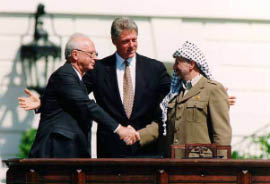
Clinton, Arafat, and Rabin in 1993 |
The Oslo Accords were an attempt to resolve the Israeli–Palestinian conflict once and for all by laying the framework for future negotiations. Palestinians would control their territory. The Israeli Army would withdraw from parts of the Gaza Strip and West Bank. The agreement would last for five years while a permanent agreement was negotiated. With the Oslo promise for peace, Israel and Palestine would have 5 years to settle the really big issues, such as Jerusalem, Palestinian refugees, Palestinian self-government, the Israeli settlements, security and borders (that big old ugly concrete wall).
Interim Palestinian self-government was to be granted by Israel in phases. We know the rest of the story: Five years came and went -- walls went up, hatred and violence continued, each side entrenching deeper. Now I wonder if there is any way to resolve the conflict.
There were two reasons why I traveled to Israel – to see the Holy Lands (and satisfy some connection with my Bible belt roots) and to try to understand the Israeli and Palestinian conflict.
Malcolm’s little talk went a long way in helping me understand the Palestinian side of the conflict. His words were strong and his heart was passionate. Malcolm didn’t pull any punches and, at times, was intimidating.
The talk was not well received by a couple of the Jewish members of our traveling group. One person (who shall remind nameless) went ballistic, swearing something like “I’m not going to take any more of your propaganda BS.” then stormed out, slamming the big conference room door like a teenager. Another asked the question: “If Israel takes down the wall, will you stop killing the kids on the school buses?” I really didn’t see a question in that statement.
Malcolm kept his cool at these emotional outbreaks (and probably rather enjoyed the show). I was a little embarrassed. I had come to Israel to hear the point of views from all sides of the people who live here. I didn’t come to hear what my fellow Americans had to say. I left without happy pictures and smiling faces. If there’s that much rift from folks in our country who haven’t experienced what it’s like to exist in the two states, how can the Jews and Palestinians, in the middle of this struggle, ever find a solution? It was, however, a most interesting way to start our day. Nobody needed coffee to charge them up that morning.
By the way, Yael wasn’t at “the discussion” that morning. I would have liked to hear her input. She did say later that the Palestinians have to take some of the responsibility for the way things are. She said they refused Israeli citizenship as a protest. They also refused to vote as a protest. She quoted Golda Myer (who held a Palestinian passport): “The Palestinians never miss an opportunity to miss an opportunity.” In spite of all the issues to be resolved, everyone knows that the Jewish people prefer the two-state option. They know that with a single state, Palestinians would outnumber Jews at some point in the future and who knows, by then they might figure out the power of block voting.
It didn’t take long for emotions to settle down in the group and, before long, we were on the bus headed to the Israel Museum. The museum opened in 2010 and is the top MUST-SEE museum in the world. However, we didn’t see any of the treasures in the main wings. We split our time between The Shrine of the Book (housing rare Dead Sea Scrolls) and seeing a model of Jerusalem.
The 50:1 scale model of the ancient city, on a quarter-acre, depicts Jerusalem during the Second Temple period 2000 years ago. It was fascinating to see how the massive Second Temple dominated the hillside. Now only the western wall, remains from the massive and grand temple. The model was designed and built in the 1960’s by the late Professor Avi-Yonah, based on his extensive research of the times right before the Great Revolt against Rome (AD 66). For a time, the model resided on the grounds of the Holy Land Hotel in West Jerusalem – which didn’t seem dignified enough for such a treasure. In 2006, it was cleaned up and moved to the Israel Museum – a much better setting. My shutter finger went crazy.
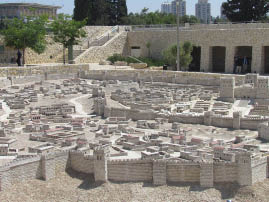
Model of ancient Jerusalem |
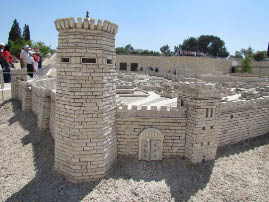
Model of ancient Jerusalem |
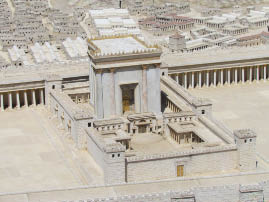
Model of ancient Jerusalem |

Model of ancient Jerusalem |
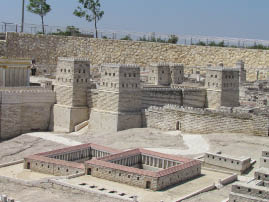
Model of ancient Jerusalem |
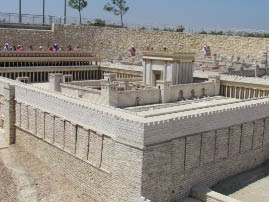
Model of ancient Jerusalem |
We walked right next door to The Shrine of the Book, the home of the Dead Scrolls. The architect designed a round building with a white dome shaped like the lid of a pot, symbolizing the clay pots in which the scrolls were found.

The Shrine of the Book |

The Shrine of the Book |
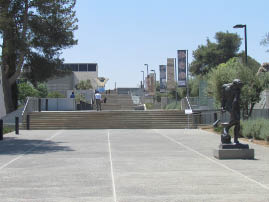
The Shrine of the Book |
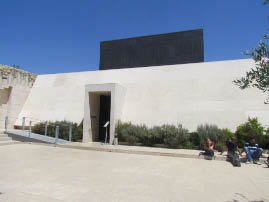
The Shrine of the Book |
Inside the round building, a giant, scroll-like wooden handle protruded into the dome ceiling. The place was dimly lit to protect the manuscripts. In the dark, cave-like environment, we walked along a downward sloping path (probably 2 or 3 stories), passing display after display of actual Dead Sea Scrolls. The place was crowded, but it seemed all the visitors, even the Americans, quietly approached each fragment, each parchment page of mystery text with respect and reverence.
In 1947, a Bedouin boy was trying to find his lost goat in a cave in the Judean desert overlooking the Dead Sea. He happened to stumble upon some jars containing seven ancient scrolls -- the first of the 2,000-year old Dead Sea Scrolls. Of course he didn’t know what he had found. Eventually the boy’s family took the scrolls to a dealer who could read Hebrew and sensed there was something very special about them. The dealer notified his scholarly relatives.
The initial excavation resulted in seven main scrolls (one engraved on copper) and bags full of fragments. Since 1956, no more scrolls have been discovered, in spite of excavations at the site and nearby.
Before coming to the museum, I knew little of the Dead Sea Scrolls. I learned that:
- Most of the scrolls were written in Hebrew with a smaller number in Aramaic or Greek.
- Most of them were written on parchment, a few written on papyrus.
- Most survived as fragments - only a handful were found intact. Nevertheless, with these fragments, scholars reconstructed approximately 850 different manuscripts of various lengths.
- Most scholars believe that the scrolls were from the library of the sect (the Essenes) that lived at Qumran. However, not all were written by the Essenes sect.
The manuscripts contain scriptures from the Hebrew Bible (earliest biblical text in the world). They also cover Sectarian topics – like history, daily life, predictions, literature, and editorials. I wish I had some knowledge of the Hebrew Bible. I was literally in the dark – a mysterious dark – in that shrine of Dead Sea Scrolls. (Of course, no photos allowed!)
After our time with the Dead Sea Scrolls in the darkness, we entered the light of day with an afternoon of more exploration ahead of us. Some of our group got to spend time at the amazing Israel Museum, some shopped, some went back to the hotel to lounge by the pool. We had booked an optional tour to Bethlehem.
The bus driver, with Yael at his side, drove us just five miles south of Jerusalem to Bethlehem’s border and dropped us. Bethlehem is in the Palestinian Territories so we had to go through check points at the wall separating the West Bank from Jerusalem. It's kind of like the Berlin Wall and hopefully, one day it too will come down when people can live peacefully together. But for now, there’s not much peace in sight. Because Palestinian and Israeli tour guides can’t cross over, we left Yael behind and met our Palestinian guide on the other side of the wall. I don’t recall the name of our guide for the afternoon, so I’ll call him Daniel – He looked like a Daniel.

The Wall |
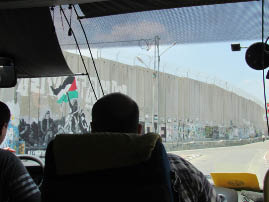
The Wall as seen from our bus. |
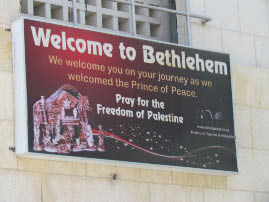
Sign in Bethlehem |
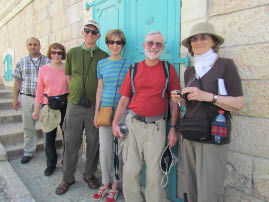
Our guide (left) with our Bethlehem Group |
Daniel was a good Catholic Palestinian boy. I could tell he had a Christian background by the way he talked about “the Savior.” His English was pretty basic and he didn’t get my jokes – but can’t hold that against him. I missed Yael and her command of the language(s) and her poetic English with a Rhode Island accent, where she learned English. Plus she got my jokes.
Oops – I digress. Back to the Bethlehem adventure. Man, what a difference a block makes! The Palestinian side felt like Tijuana, coming from San Diego. The roads and buildings and houses seemed dingy. That huge, ugly concrete wall, added a feeling of entrapment. It takes big bites out of the Palestinian territory, staking out more “prime” land for Israeli-controlled territory. We saw an example of how the wall juts out for about a mile into Bethlehem to claim the church that houses Rachel’s tomb. (Rachel was Jacob’s wife who died in childbirth.)
There was a lot of interesting graffiti on the Bethlehem side. We stopped, in silence, to take several pictures of the wall. Seeing the wall from the Palestinian side was more important in my quest to understand this country than seeing the place where Christ was born.
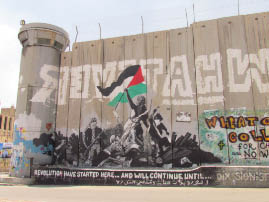
Graffiti on the Wall |
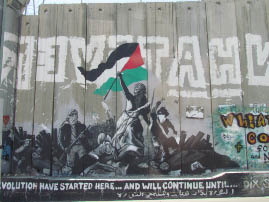
Graffiti on the Wall |
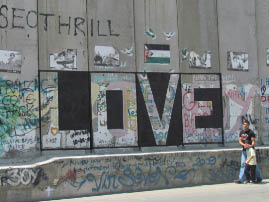
Graffiti on the Wall |
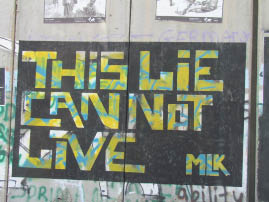
Graffiti on the Wall |
We stopped in Palestine to have lunch at a little hole-in-the-wall café. Bill and I already had lunch – bread and cheese pilfered from our enormous breakfast buffet. The table we sat at was wobbly and someone spilled a huge coke. Funny the things you remember.
Bethlehem is a really BIG holy site claimed by Judaism, Christianity and Islam. For Jews, it is the burial place of the matriarch Rachel and the birthplace of King David. For Christians, it’s the birthplace of Jesus and was one of the oldest Christian communities in the world. (I’m not sure of the Islam connection.)
Maybe it was my mood – but I saw a once-grand old ancient city badly in need of a face lift. The Palestinian Authority poured millions of dollars into this town to attract tourists – mainly Christians on pilgrimages to the birthplace of Jesus. In spite of the fact they’ve built roads, shops, and hotels, it just isn’t as spiffy as what the Israeli’s have to offer on the other side of the wall.
Bethlehem has a population of about 30,000 people, and declining steadily over the past decade. Christians, once the majority, now make up only about 1 or 2 percent of Bethlehem’s population. When it became a Palestinian controlled territory, Christians moved out in flocks.
With some deviations, Bethlehem’s history is similar to other ancient cities in the area. It was first settled by Canaanite tribes (who built a temple to their god Lahama). Philistines came next (1200 BC) to build a garrison to control this important strategic location. The Israelites ruled for a while before the Greek takeover. In 160 BCE, it was time for the Romans to occupy. And the rest of the story … Bethlehem fell under the control of Jordan following the Israels War of Independence in 1948. Then after the 1967 Six-Day War, the Israelis took control. Now Bethlehem is a Palestinian-controlled territory. Who knows what will happen next.
Our guide told us that in Hebrew, the town is Bet Lehem ("House of Bread") and in Arabic it is called Bet Lahm ("House of Meat"). Guides always tell you stuff like that.
For hundreds of years, Christian pilgrims have made the roughly 2½ hour walk from Jerusalem to Manger Square in Bethlehem. For us, it was 10 minute bus ride from Jerusalem and a five minute walk to the Square.
Manger Square is where the really big Christmas celebrations are held each year – and on three different dates -- December 24 for the Christian Christmas Eve, January 6 for Greek Orthodox and January 19 for Armenians. Busy place.
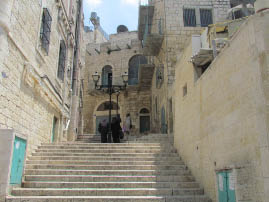
Bethlehem |
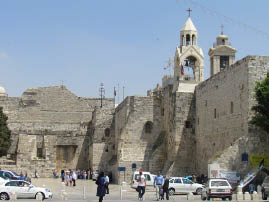
Bethlehem |
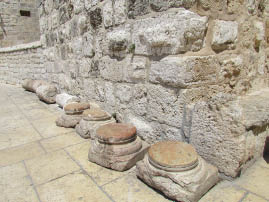
Bethlehem |

Bethlehem |
Our first stop was the Church of the Nativity, built over the grotto where Mary gave birth to Jesus. It’s one of the most “sought after” (or should I say “fought after”) holy sites in the world. For centuries, it was both captured and defended by a succession of armies – and destroyed and rebuilt by the powers that be.
The Church of the Nativity was first built in the 4th century by Helena, the mother of the Byzantine Emperor Constantine. She must have been something – building churches everywhere (especially over holy sites) and spreading Christianity around the word. She was also the one who got the construction of the Church of the Holy Sepulcher in Jerusalem underway.
The entrance to the church is a low doorway called the Door of Humility. Some say the Muslims, during their rule, installed the door to remind Christians that they were guests in the country and must bow to their hosts. A more likely story for the short door was to keep nonbelievers from riding their horses into the church on horseback or looters from hauling wagons of marble and precious artifacts out.
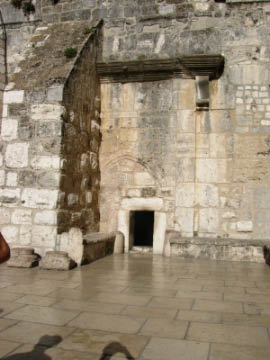
Door of Humility |
The church’s long entry hall (nave as they say) is dark and dreary and lined with four rows of Corinthian pillars. The pillars have faded pictures of the apostles on them along with graffiti and carved names of visitors left over from centuries. The floor of the nave has a hole (that was once a trap door) that allows you to see some pretty amazing Byzantine mosaics that covered the original church floor. At the end of the nave is the main altar of the Nativity with a lot of dusty gold and silver crap hanging over it – not at all what I expected.
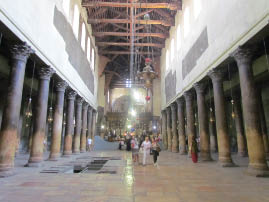
Church of the Nativity |

Church of the Nativity |
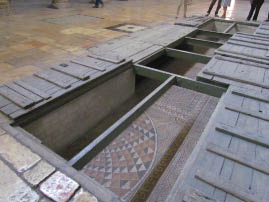
Church of the Nativity |
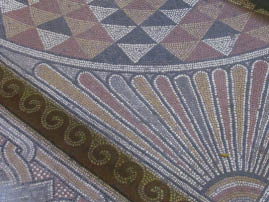
Church of the Nativity |
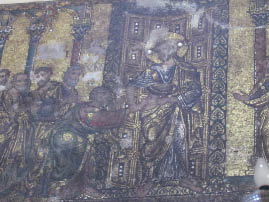
Church of the Nativity |
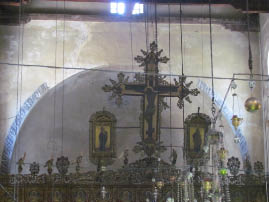
Church of the Nativity |
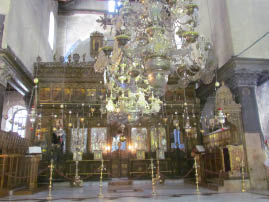
Church of the Nativity |

Church of the Nativity |
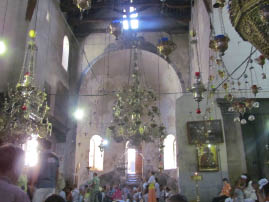
Church of the Nativity |

Kim and Richard at the Church of the Nativity |
We walked down the narrow dark staircase by the side of the altar that led us into a packed claustrophobic cave. This was the grotto where Jesus was born -- the most holy spot in the worldfro Christianity. A silver star in the floor marks the birthplace of Jesus. We didn’t wait in the long line to bend down and kiss it the star. I managed to get a shot of it in between believers. Granted most of my pictures were butt shots – but that’s how it is. A few steps away was the manger behind a chained link fence where Mary placed the baby. The fence kept the kneelers and kissers away.
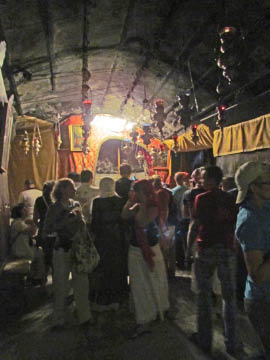
Church of the Nativity |
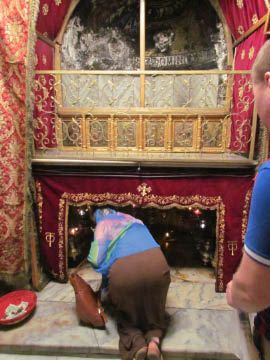
Church of the Nativity |
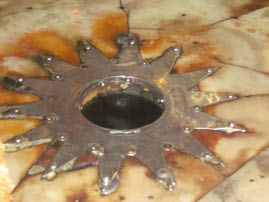
Church of the Nativity |

Church of the Nativity |
The Church of the Nativity, like the Church of the Holy Sepulcher in Jerusalem, was in need of repair and a good scrubbing – pretty depressing. Various Christian denominations share control over different parts of the church. Committees and in-fighting just aren’t able to give those holy sites the care they deserve and it’s a shame. The grotto is under the jurisdiction of the Greek Orthodox Church while much of the church is Armenian.
Connected to the Church of the Nativity and right next door is c. By contrast, St. Catherine's was bright and clean. The traditional midnight mass celebrated on Christmas Eve is broadcast from this church. Maybe the worldwide media exposure keeps the place in tip top shape. The church was built by Franciscans in the 1880’s over a 12th Century monastery, which in turn, was built over a 5th Century monastery, associated with St. Jerome.

St. Catherine's Roman Catholic Church |
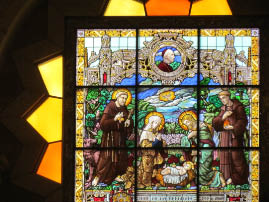
St. Catherine's Roman Catholic Church |
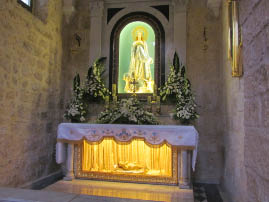
St. Catherine's Roman Catholic Church |
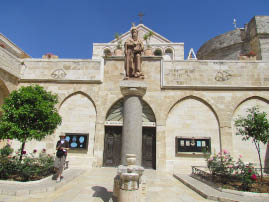
St. Catherine's Roman Catholic Church |
We went down into a series of underground caves and tunnels to see the Chapel of St. Jerome and his tomb. It seems weird, but I am a big fan of St. Jerome and have been ever since I first learned of him while we were visiting Turkey. We saw where he lived in the caves in Cappadocia which was the IN-spot for meditating monks. St. Jerome traveled a lot and made his mark as the top dog scholar of the early Christian Church. He was born near Venice (342 – 420 AD) and in 384, settled in Bethlehem. For a time, he was the Bishop of Bethlehem and founded a monastery. His really big claim to fame was translating the Old Testament into Latin, the commoners’ language, and replacing many different texts out there in circulation. By using Latin, he opened up the Bible to the masses – some of the powers that be within the church weren’t so pleased with that idea. Down in these tunnels, he worked with his gang of Bethlehem monks, burning those candles at both ends and scribing out lots of Bibles. His work later became known as Vulgate – Google it to learn more.
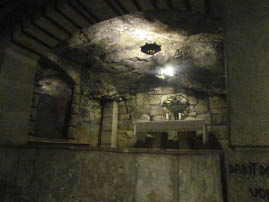
Chapel of St. Jerome |
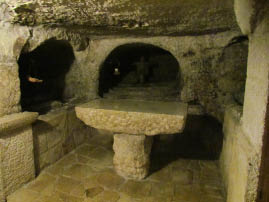
Chapel of St. Jerome |

Chapel of St. Jerome |
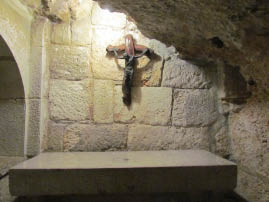
Chapel of St. Jerome |
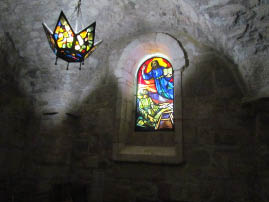
Chapel of St. Jerome |
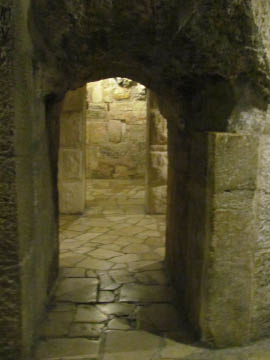
Chapel of St. Jerome
|
We said good-bye to St. Jerome and Manger Square and boarded the bus for a traditional olive-wood-carving shop. We had some trouble finding the place. It was in the back of a house in a residential neighborhood. We entered to find about 8 guys in 4 or 5 in small rooms, turning out carved religious figures, in the worst of working conditions. It has hot, oppressively hot. There was no circulation. The saw dust filled our nostrils and we couldn’t breathe. The floor was knee deep in saw dust. The table saw looked exceptionally dangerous. Where’s OSHA when you need them? Piles of carved Jesus and Mary figures littered the floor. The craftsmanship on the figures looked great. I wanted to buy a Mary or two, but a Gift Shop in this factory is only a dream. We were all glad to get out of that oven of a workshop. We all felt badly for the guys working there – I’m sure any labor protection laws, like a fancy Gift Shop, are a long way off.
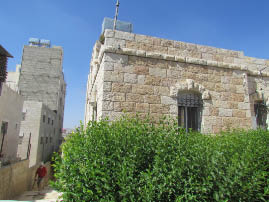
Wood Carving Shop |
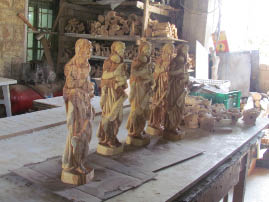
Wood Carving Shop |
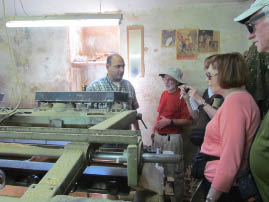
Wood Carving Shop |
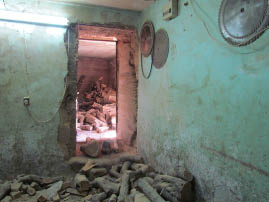
Wood Carving Shop |
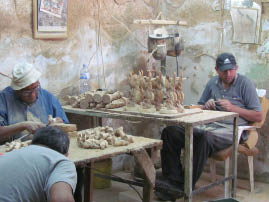
Wood Carving Shop |

Wood Carving Shop |
Our next stop was the Shepherds' Souvenir Shop, owned and operated by Christians. It appeared as if all the tour buses stopped at this place. That’s good for the Christian businesses because only 1 or 2% of the people living in Bethlehem are Christian. I searched the shelves of kitschy Christian trinkets and ended up buying small olive-wood boxes as gifts for friends back home. One of the salespeople at the register was a Middle Easterner (no doubt Christian). He told us his brother lives in Texas. He has applied for a US travel visa 11 times -- each time he was charged the fee (about $200) and turned down. His dream is to someday travel to the U.S. and see the “Abraham Lincoln Memorial.” I hope he makes it.
After we loaded up on souvenirs, we went to Shepherd’s Field. This is where angel Gabriel appeared and frightened some Shepherds with his glorious Jesus birth announcement. -- “Born tonight in the City of David … blah blah blah….”
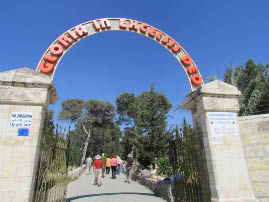
Shepherd’s Field |
We went into the little church built in 1954 by the Canadians and shaped like a Shepherd’s tent. If you have to build a church over a holy site, this was a nice way to go. I also liked the surrounding fields -- seemed authentic enough. It was fairly easy to imagine shepherds keeping watch over their flocks by night. However, out back was The Shepherds’ Cave, which seemed considerably less authentic. This was the place where the shepherd and his animals went for protection and to sleep and eat. It was a dreary place. The altar, the star-lights carved in the walls and ceiling, and the manger scenes screamed to me “tourist trap!” We weren’t in there long when a busload of Christians speaking in southern accents (Good ole’ boy and Sweet as Sugar Pie types) filled the place with their spirits. They began singing a hymn – don’t recall which one – probably “Amazing Grace.” I was glad they dropped by to brighten up that cave and remind me of my heritage. I miss my folks.
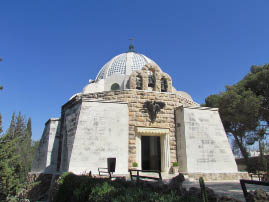
Church at Shepherds’ Field |
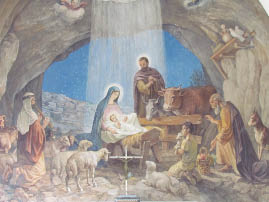
Church at Shepherds’ Field |
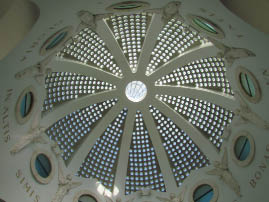
Church at Shepherds’ Field |
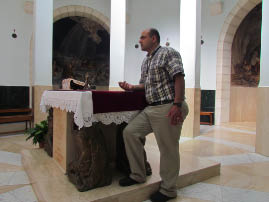
Church at Shepherds’ Field |
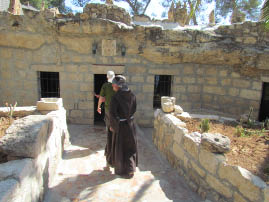
Church at Shepherds’ Field |
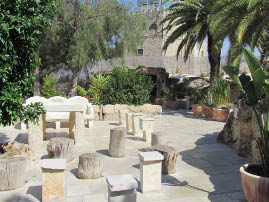
Church at Shepherds’ Field |
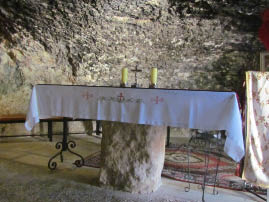
Church at Shepherds’ Field |

Church at Shepherds’ Field |
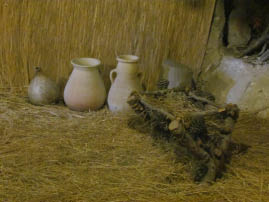
Church at Shepherds’ Field |
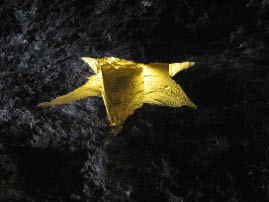
Church at Shepherds’ Field |
There, we had done Bethlehem and finished up with our good-bye to Daniel and his bus driver companion. We had no trouble getting through the Israeli checkpoint. There was no wait and no need for passports -- not at all what we had been told or expected.
We hooked up with Yael and our trusty Israeli bus driver at the border and headed back to Jerusalem. I was disappointed in Bethlehem, not at all as I had imagined it.
However, I was glad we went because it was here, in the Palestinian controlled territory that I could see the differences (and inequalities) in the two state system where one holds all the cards. On that short 10-minute bus ride back “home” to Jerusalem, I looked up at the closed settlements perched on the hill. A country that puts so much effort into separating its people doesn’t have much chance of healing wounds and making peace.
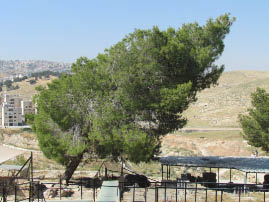
Driving back to Jerusalem |
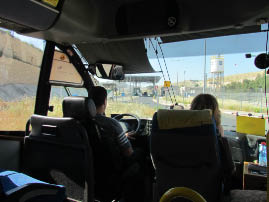
Driving back to Jerusalem |
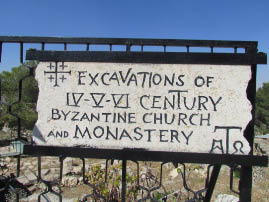
Driving back to Jerusalem |

Driving back to Jerusalem |
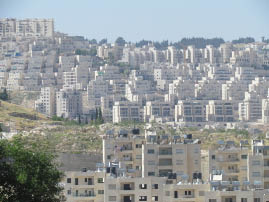
Driving back to Jerusalem |
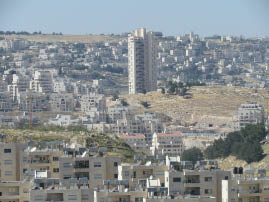
Driving back to Jerusalem |
In no time we were back the Mt. Zion Hotel, making that treacherous U-turn and then being delivered safely to the door. We had time to regroup, check emails and shower before dinner.
Feeling like new, Bill and I walked down to the Cinematheque – the movie house and restaurant with fabulous views of both our hotel and the ancient city. We ordered wisely this time and were happy with our shared burger and fries, and some beer, of course -- starting to feel at home in old Jerusalem.
We met the group in the hotel lobby at 8:40 to walk to the Old City to see the lightshow (billed as the Night Spectacular) in the Tower of David Museum. I forgot to bring my glasses, but I saw enough to think it’s the best entertainment that ever flowed out of a projector (rather 20 projectors, 10 video players, multiple speakers controlled by 14 computers in two projector rooms). Scenes of 3000 years of Jerusalem history flashed by on the walls of the old citadel – one titanic of a movie. The 45-minute show was full of surprises, starting with a 10-story high image of David playing on a harp and ending with the simple words, “Pray for Jerusalem.” The only thing that got in the way of my emotions was the persistent thought -- How the heck did they do that! A French multimedia company, Skertzo, did the production. What wizardry – well worth the $20 or $30 per ticket!
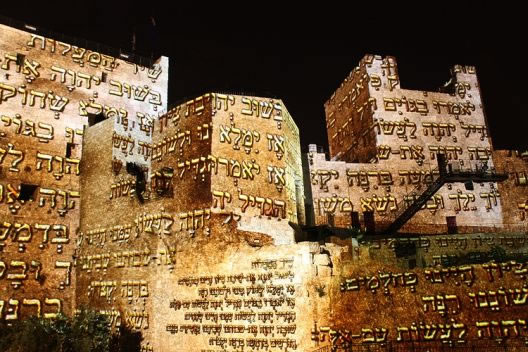
Lightshow |
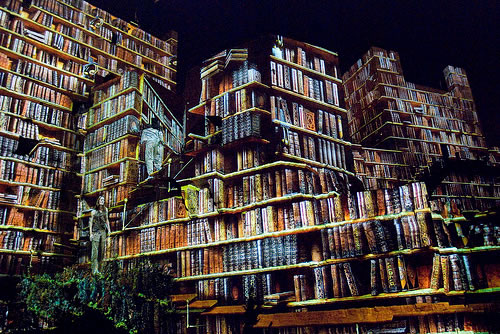
Lightshow |
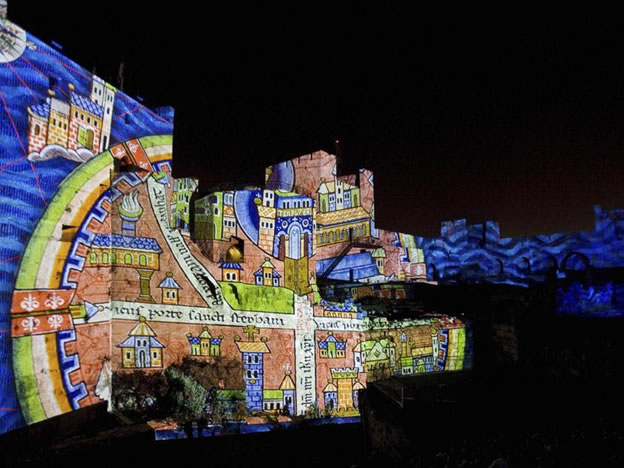
Lightshow
|
5/11/12 - Friday - Jerusalem - Day 4 – En Kerem / Herod’s tomb / Sabboth at the Wailing Wall
We enjoyed another GREAT BREAKFAST at the Mt. Zion hotel before we loaded on the bus and headed 4 or 5 miles southwest to En Kerem, a quaint little town nestled on the southern slopes of Jerusalem.
En Kerem is where John the Baptist was born and the home town of his folks -- Zechariah and Elizabeth. It’s also the place where Mary (was pregnant with Jesus) visited her cousin Elizabeth (pregnant with John the Baptist).

En Kerem |

En Kerem |
I really liked the ancient village of En Kerem, with its picturesque lanes, churches, galleries, craft shops, and restaurants. Yael said it went into decay over the centuries, then was discovered and saved by artists. Thank goodness for artists. Now En Kerem is a fashionable and expensive place to live -- great for a little B&B get away.
We came to see the two churches -- the Church of John the Baptist and the Church of the Visitation. Although both structures are relatively new, both are constructed over the remains of much older buildings that marked two important holy sites – the place where John the Baptist was born and the place where Mary came to visit her cousin Elizabeth (who was pregnant with John at the time). We also made a stop at Mary’s well, the ancient village spring – still springing.
The parents of John the Baptist, Elizabeth and Zechariah, had quite a story. Their families were in the priesthood business and Zechariah continued on in that line of work. Elizabeth couldn’t have any children. They had given up because she was pretty old – past menopause. Well, low and behold, an angel came to Zechariah to tell him that Elizabeth was going to have a son and they are to name him John and that the son is going to grow up to be great. Zechariah doesn’t believe a word the angel says so the Lord makes him mute. Turns out Elizabeth gets pregnant and mute Zechariah can’t say a word during the entire pregnancy. About the same time Mary, Elizabeth’s cousin, found out from another angel that she’s going to have a son even greater -- that would be Jesus. Elizabeth comes to this area in the country (her family’s farm) to get away because she’s uncomfortable and embarrassed about being an old lady and pregnant. Mary comes to the country to visit Elizabeth. It’s good for Mary to get away because she is uncomfortable with being pregnant and unmarried. The two cousins helped each other get through this rough time. We saw the spring where they hung out and talked.
We first went to the Franciscan church, the Church of John the Baptist (or in Hebrew -- St. John ba-Harim -- St. John in the Mountains) – the birthplace of John the Baptist. It was a lovely quiet place. On the courtyard wall were 24 different tile plaques in 24 different languages, all displaying the song of thanksgiving that Zechariah blurted out when John was born (the Benedictus - Luke 1:68-79). We went inside the church to check out the supposed birthplace place of John the Baptist.

Church of John the Baptist |

Church of John the Baptist |

Church of John the Baptist |

Church of John the Baptist |
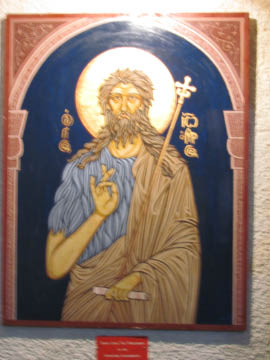
Church of John the Baptist |
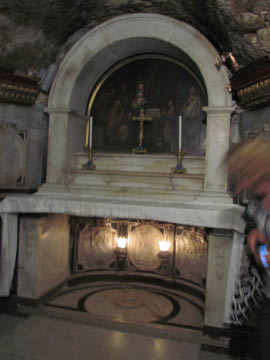
Church of John the Baptist |
Our next stop was the spring (also known as Mary’s Spring). By the way, En Kerem means “spring of the vineyard.” It was easy to imagine the Blessed Virgin and her cousin stopping here for a drink and a chat.

Mary’s Spring |

Mary’s Spring |
From Mary’s Spring, we walked up a fairly steep hill to the Franciscan Church of the Visitation, commemorating Mary’s visit to Elizabeth. The views of the vineyards from the hillside were beautiful and reminded me of Tuscany. We were on the path with several other pilgrims (notably from India) up to the church. We passed a couple of the monasteries tucked away on the hillside. (I believe the Russian monastery was gated off from the Armenian monastery with lots of in-fighting between the two.)

Church of the Visitation |

Church of the Visitation |
At the top of the hill sat the Church of the Visitation, supposedly built on the family farm of Elizabeth and Zechariah’s. The church was dedicated to women and designed by Antonio Barluzzi (1884-1960). It was completed in 1954 over former Byzantine and Crusader ruins. I was surprised to run into Barluzzi’s work again. He was an Italian Franciscan monk known as the "Architect of the Holy Land." This was the third church of his that we saw in the Holy Land and my favorite. The others were Church of the Beatitudes and the All Nations church in the Garden of Gethsemane.
On the front of the upper church was a beautiful mosaic of Mary on a donkey, escorted by angels, on her way from Nazareth to the hill country of Judea. The place had a wonderful “girlfriend feel” about it – white roses in the garden, a sweet, sensitive statue of two pregnant women together in the courtyard, and many paintings and stained glass windows depicting women. Also, posted in the courtyard on ceramic plaques in 47 languages were the hymns that Mary prayed when she met Elizabeth (Mary’s Magnificat Luke 1:46-55).

Church of the Visitation |

Church of the Visitation |

Church of the Visitation |

Church of the Visitation |

Church of the Visitation |

Church of the Visitation |
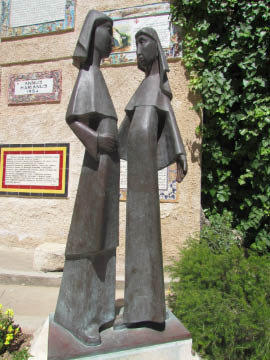
Church of the Visitation |
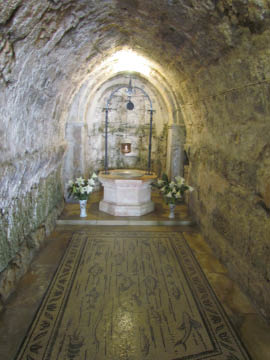 Church of the Visitation Church of the Visitation |

Church of the Visitation |

Church of the Visitation |

Church of the Visitation
|
 Church of the Visitation Church of the Visitation |
I like to call the lower church “The Girlfriend” Church because of the many touching frescoes of Hebrew women from the Bible known for their hymns or songs of praise. A priest was giving a sermon while we were there – it seemed like a happy place.

Church of the Visitation |

Church of the Visitation |

Church of the Visitation |
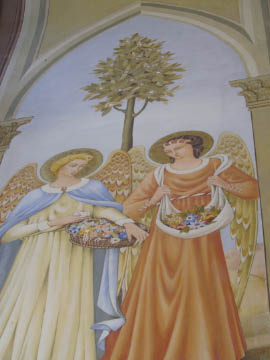
Church of the Visitation |

Church of the Visitation |

Church of the Visitation |
We walked down the hill and back to our bus. I really liked that little town – the girlfriend place.
On our way to our next adventure, we made a stop in some settlement for Dean. It had something to do with the Boy Scouts. It wasn’t easy finding the place and Dean wasn’t able to complete his mission, but at least I got a peak at life in a settlement behind the walls. It didn’t have that Mr. Rodgers “Hi Neighbor” kind of feel.

West Bank Settlement |

West Bank Settlement |

West Bank Settlement |

West Bank Settlement |

West Bank Settlement |

West Bank Settlement |
The bus dropped us off at our next stop, Herodion. From the hillside, we got a bird’s eye view of the sweeping desert below with Arab villages and Israeli settlements scattered out in three directions. Yael pointed out some of the “problems” with the settlements in the valley below. Breaking rules and causing havoc, Palestinians put up unplanned settlements hooking into the already overloaded water system. No building codes here! Sometimes they can connect to the sewage system, sometimes not. Trash pickup is another big issue with these renegade towns, not to mention the effects on the environment. On the other hand, Israel continues to expand into Palestinian territory without any repercussion. It seems both groups, drawing from decades of hatred; find new ways of making one another hate each other.

West Bank Settlement |

West Bank Settlement |
Editorial Note: I wish I had heard (and could recall) more of Yael’s discussion. Yael is an Israeli, but I can tell she is trying to give an objective view, not an easy task – especially since she believes in speaking her mind. From my naïve eyes, it looks like the Palestinians got screwed – and maybe weren’t able to avoid it. I understand that the issue is more complex than what is visible on the surface. And I understand that there are injustices that lie on both sides of the conflict. Still, it is difficult for me to get the extreme disparities in wealth, or the wall keeping Palestinians from entering Israel (while the Israelis are free to enter the West Bank) or the expansion of settlements in the heart of Palestinian cities. I also don’t understand why the international community has been so passive about the issue and how the US policies have added to such discrimination in the name of national interest. – END of editorial note – sorry I even got started …
We walked to the Herodion National Park headquarters; a hilltop fortified palace built by Herod the Great. From the road and from the park headquarters, Herodion didn’t look like much – just a rounded off hill (flat top) in the bone dry desert where thistles seemed to be the only plant that survives. Well, it turns out that cone-shaped mountain is man-made and within its volcano-like walls is the circular palace-fortress built by Herod in 24-15 BC. After I saw some aerial photos of Herodion, I was completely blown away by the Herod’s tenacity as an architect and a builder. Here, he produced yet another nature-defying monumental building project. This one was even better than his other mind boggling creations – the ancient city of Caesarea and its man-made harbor, two palaces atop Masada, a winter palace in Jericho and a Temple in Jerusalem on Temple Mount.
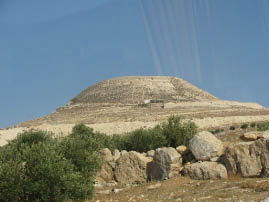
Herodion |
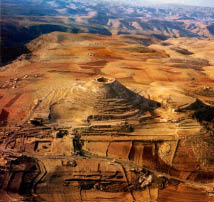
Herodion |
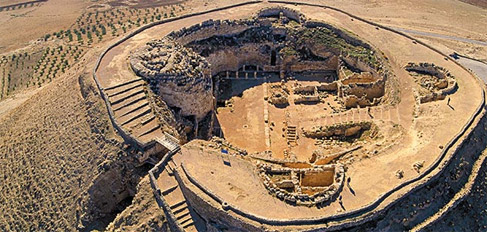
Herodion |
Why would Herod build such a prominent fortress—the largest palace complex in the Roman world—on the edge of a desert? I suppose his huge ego and arrogance drove him to it – plus he liked desert country club retreats. He also built it to show off that he defeated Antigonus, his rival. The main reason was he wanted it to be his mausoleum.
He wasn’t satisfied with the landscape nature had given so he increased the mountain's height. His crews carted in soil and rocks from surrounding areas to the summit. They piled all that earth up some 65 feet high and combed it over the original slopes like a child's carefully smoothed sand hill. Built as part of that giant ant hill were four towers jutting up into the sky, a massive round one and three semicircular towers.
We climbed down into Herod’s palace home to see the ruins of the towers, the courtyard, palace baths, the dining room, living quarters (separate for family and for soldiers) scattered with fragments of mosaics and columns. We climbed down to see the cisterns, storage warehouses (stocked with goods and treasures) and caves.

Herodion |

Herodion |

Herodion |

Herodion |

Herodion |

Herodion |

Herodion |

Herodion |

Herodion |

Herodion |
On the way back down the hill, we passed by the royal 450-seat Roman theater (that was off limits – some serious excavations going on here). We looked down at the bottom of the hill to see the ruins of Lower Herodion – once an ornamental garden and a large pool. The pool served as the main reservoir. Rain water and surrounding aqueducts fed the reservoir. Herod’s employees lifted the water to the hilltop palace by a bucket and rope system. Anything was possible back then.

Herodion |

Herodion |
Decades passed and Herod’s palace fortress (and tomb) went into decay. The building was almost completely destroyed by Jewish rebels who arrived here at the beginning of the Great Revolt against Rome in 66 AD and lasted until the Second Revolt in 135 AD. At one point, Herodion became the headquarters of the Jewish leader Bar-Kokhba. Using Herod’s cisterns, the rebels turned the underground into an amazing system of escape tunnels and hideouts. They could easily strike the Roman troops and cause a lot of damage -- like the guerrilla fighters in the Cu Chi tunnels in Vietnam. They also remodeled Herod’s grand bathsto fit their more merger needs – smaller ritual baths with seven steps down. Those rebels were pretty strappy until the Romans figured out their system and smoked them all out of the caves.
300 years later, around the 5th century, the once desert palace-turned rebel hideout morphed again into a monastery with cells and a chapel adorned with carved Christian symbols.
Years passed and Herodion had faded back into desert. In the 1800’s, a fascination with Herod’s tomb in the hills of Judea became a scholarly treasure hunt. The searchers agreed that Herod was buried somewhere in Herodion because Flavius Josephus tells us so. It was nice to bump into Josephus again. He was a well-known, first-century Jewish historian, born in Palestine about 40 years after Herod‘s death in 4 B.C. His clear and accurate accounts guided many an archeologist.
The 45-acre desert retreat was first excavated in the 1960s by Father Virgilio Corbo. However it was first positively identified in 1838 by Edward Robinson, an American scholar with a knack for locating biblical landmarks. The Germans came next with more extensive surveys, but the tomb remained a mystery.
Ehud Netzer, a famous archeologist from the Hebrew University, dedicated his life to finding Herod’s tomb. For 35 years, he studied the writings of Josephus and followed the road from Jerusalem to the valley. He was stumped and thought Herodion had to be in the valley. He spent a lot of time searching there, but got a breakthrough when he searched the top of the mountain. Finally, in 2007, he announced that he had found Herod's resting place. Unfortunately, he fell while he was excavating the Roman theatre and seriously injured himself. He was 75 and died a few years later (2010) from his injuries – but he was doing what he wanted to do.
In spite of all his architectural feats, Herod is remembered for its ruthlessness and paranoia. He tortured and killed family members, servants and bodyguards, to say nothing of his real enemies.
Yael told us he was a tough little guy and liked to show off by running up and down these mountains to everyone’s amazement.
He probably was a Mamma’s boy and unstable. Josephus (that first-century historian) writes that as Herod and his family were fleeing from Jerusalem (and his rival Antigone), the chariot carrying Herod‘s mother overturned and she was seriously injured. Herod was so shocked that he tried to commit suicide. He drew his sword and tried to fall on it, but his friends restrained him. His injured mother eventually recovered and he made a pledge to build Herodion, his fortress palace retreat and a Mausoleum for himself. As part of his funeral plans, he planned a long road from Jerusalem lined with trees for the procession. In the end, because he was such a nasty guy, his palace and tomb were destroyed – only to be pieced back together some 2,000 years later.
Next stop on the way back to Jerusalem was lunch at Elias’, a restaurant in the Mar Elias Monastery. The huge cave-like hall restaurant was authentic and ancient and the food was good. However, it was set up for large tour groups and the echo in there boosted by my hearing aids and made me batty. (Get it? -- cave / batty. Whatever, it was very annoying.) I just sat quietly and stuffed myself with humus, pita, beer and chicken (not sure about the chicken) kebobs and fries. Bill and I shouldn’t have had the beer.

Elias Restaurant |

Elias Restaurant |
After lunch we visited the Greek Orthodox chapel, built over the ruins of a Byzantine church in the sixth century AD, then rebuilt again in the twelfth century. Many a pilgrim stopped here on their way to Bethlehem.
Mar Elias Monastery was named after Prophet Elijah (St. Elias), who according to tradition, stopped here on his way to the south while fleeing from the anger of Queen Jezebel – that wicked Jezebel. Here’s how the story supposedly goes.
Elijah wasn’t thrilled with King Ahab and Queen Jezebel’s policies on religion. The evil King and Queen sided with the Phoenician deity Baal while Elijah insisted on the one true God. To show that he was on the real God’s side, he told King Ahab that there would be a terrible drought in the land – and there was. That got Ahab’s attention. Next Elijah challenged 450 prophets (from the Baal Team) to a contest on Mount Carmel. Both sides were given a bull and told to make a sacrifice (which required fire) to their God. However, they weren’t allowed to start a fire – that was up to their God to do – Baal’s God or Elijah’s One True God. After much chanting and worshipping, no fire came for the Baal team, but blazes a’plenty came from Elijah’s God, even after he had doused his sacrifice with water. Perhaps Elijah overdid it, taunting his losing opponents. He made his point that there can be only one God. But then to drive the point home, he had the 450 Baal prophets (along with lots of their friends and family) executed. Jezebel was not pleased with losing her Baal Buddies, so she had her henchmen try to track him down – but he escaped. He also, with the help of the true God, ended the 3-year drought in the country.
As for wicked Jezebel, she had a bad ending. She was thrown (from her palace, I believe) into the streets where she died. Her body was left there for the dogs to finish off. I remember that well from my religious training as a kid. I also recall that Elijah ascended into heaven in his chariot of fire.
Yael told us that Elijah was a loner, certainly not a team player, and liked to have his opposition wiped out. In spite of this violence, he is like Santa Claus to Jewish kids. To me, he’s weird and his story makes no sense. All I can say is that he must have been on drugs – some serious cactus peyote or maybe he was dehydrated in that desert. I just don’t get it -- maybe I was burnt out (or brain dead from the beer I had at lunch). However, except for the skeleton, I did like his chapel.
NOTE: The skeleton was a young religious monk preserved through the centuries, chained in death as in life. In the middle of one of the rooms was a skeleton laid out on the floor. A handful of objects were also recovered: a ceramic cup, a jug, a bronze and glass lamp, a knife, an iron belt buckle and a pair of horseshoes. Based on these finds, scholars have dated the entire complex to the Byzantine period (sixth–eighth centuries A.D.).
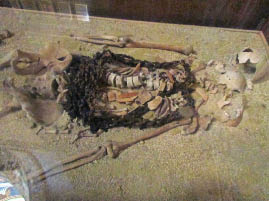
Mar Elias Monastery |

Mar Elias Monastery |

Mar Elias Monastery |

Mar Elias Monastery |

Mar Elias Monastery |

Mar Elias Monastery |
Mar Elias, the looming monastery on the hill, seems to attract violence. During the independence war in 1948, the Egyptians and their allies battled the Israeli troops here. Until the Six Day war in 1967, the Mar Elias hill was a Jordanian post. In 1956, a Jordanian soldier opened fired on a group of archeologists from the Israel Exploration Society killing four of them. The place was named “the hill of the four” in memory of the archeologists. Later, in 1967, an Israeli jet crashed into the hill and some now call it the “hill of the airplane.” I think it should be called the “killing hill.”

Mar Elias Monastery |

The Hill of the Four |
It was just a short ride back to Jerusalem and our wonderful old hotel. We had some time to freshen up and meet the bus at 6:30 to go to the Old Jerusalem for the kickoff of Shabbat which is celebrated every Friday for hundreds and hundreds of years.
I could feel the tension mounting as we walked toward Ground Zero of the Jewish world -- the Wailing Wall – on the eve of the Jewish Sabbath. The wailing had already started and would go until the bell rings at sunset. We were allowed to take photos up until the bell ringing. I was snapping like crazy in that glorious golden, twilight hour.
It was magical, like the rolling back time to a film where the setting is in Europe sometime in the 18th or 19th century. Women wore long-sleeved shirts and skirts. Married women covered their heads with wigs (sheitels) or scarves. The men wore long black coats and fedoras or round, fur-covered shtreimels. Most have tzitzit (to remind them to abide by some 614 rules) hanging below their shirts. Young boys sported very long hair. (Boys don’t get their first haircuts until they're three.) Older guys had long side curls (peyis).

The Western Wall |

The Western Wall |

The Old City |

Going To Shabbat |

The Western Wall |

The Western Wall |
Families, multi-generational families, all seem to be in a hurry, rushing to the Wall to start their wailing. I don’t know where they dropped the kids, but I saw only the post puberty types, separating male and female by a short wall.
The guys in our group were given yamalkas to wear and entered the male section. I was, of course, relegated to the female side – just me and my camera and unreal visions before my eyes. On my feminine side, the serious women were praying at the wall, while the more playful joined arms in a circle dance.
I climbed on a plastic chair to see the action on the men’s side. Seemed the men were organized according to their particular sects -- fur hat and silk coat section, regular yamalkas, crocheted yamalkas (the good guys, I am told), tall hats, rounded hats and so on. Yael told us that the tall fur hats cost several thousand dollars -- not very practical for this climate or the families’ budget. They are usually given as wedding presents to the men and then passed on. When it rains, the guys, looking exceptionally odd, wear them wrapped in plastic. (The Orthodox fur hat dealers are a clever lot finding an easy customer base who never, ever change styles.) I spotted Bill, in his yamalka looking very cute and Jewish and videotaping everything in sight.

The Western Wall |

The Western Wall |

Shabbat in Old Jerusalem |

Bill videotaping everything in sight |
Although I did not hear it very well, the bell (or buzzer) sounded precisely at sunset signaling the start of the Jewish Sabbath. For 24 hours, no working, no smoking and for me, no more photographs for the rest of the evening (at least in public in the vicinity of the Wailing Wall).
The action at the Wall dissipated in the fading light. The families all seemed to find each other again and headed home or to a restaurant or Lord knows where. The little kids were all dressed up and prancing around with their proud parents and grandparents. I love watching the families celebrating together – and to think they do it every Friday night. No wonder Judaism has survived for all these years.

Old Jerusalem |

Old Jerusalem |

Bill and Nancy |

Don and Pat |
We hung out a little more and then hooked up with Don and Pat to find a restaurant nearby -- not an easy task with all the Jewish places closed and most tourists out looking for a place to eat. Bill had done his research and found The Armenian Bar. Our timing was great. Descending down the steps into the cozy cave-like restaurant was like turning back the centuries. Bill and I had the special -- hamburger patty with veggies cooked in a yogurt soup – how very tasty.
We walked back to our hotel -- beautiful evening. We’re going to miss Jerusalem and our hotel and Don and Pat (our buddies)! |











